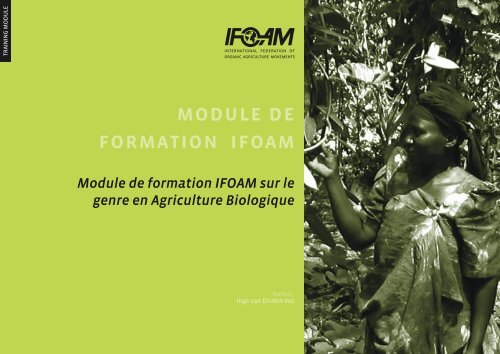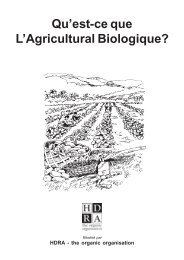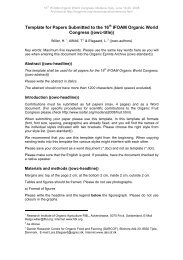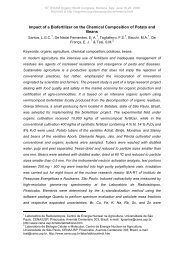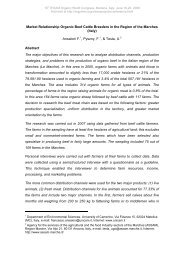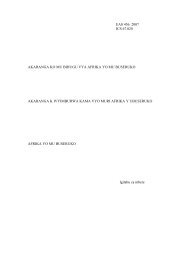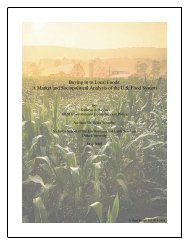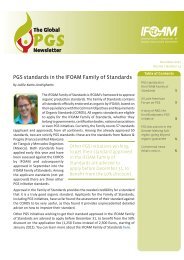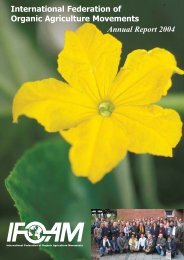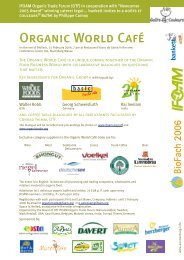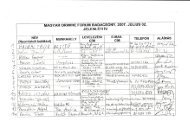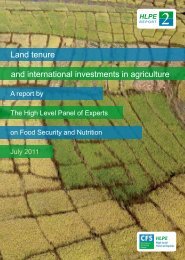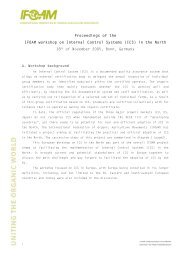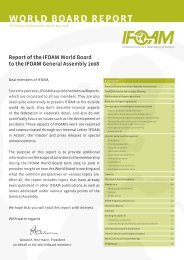Module de formation IFOAM sur le genre en Agriculture Biologique
Module de formation IFOAM sur le genre en Agriculture Biologique
Module de formation IFOAM sur le genre en Agriculture Biologique
You also want an ePaper? Increase the reach of your titles
YUMPU automatically turns print PDFs into web optimized ePapers that Google loves.
TRAINING MODULE<br />
modu<strong>le</strong> <strong>de</strong><br />
<strong>formation</strong> ifoam<br />
<strong>Modu<strong>le</strong></strong> <strong>de</strong> <strong>formation</strong> <strong>IFOAM</strong> <strong>sur</strong> <strong>le</strong><br />
<strong>g<strong>en</strong>re</strong> <strong>en</strong> <strong>Agriculture</strong> <strong>Biologique</strong><br />
Auteur :<br />
Inge van Drut<strong>en</strong> Vos
Ce manuel a été commandité par <strong>IFOAM</strong> et financé <strong>sur</strong> son programme “<strong>IFOAM</strong> –<br />
Growing Organic II” (I-GO II), qui vise à développer <strong>le</strong> mouvem<strong>en</strong>t biologique dans <strong>le</strong>s<br />
pays <strong>en</strong> développem<strong>en</strong>t. I-GO II est financé par HIVOS, Pays-Bas et <strong>le</strong> « Fond pour une<br />
gestion durab<strong>le</strong> <strong>de</strong> la biodiversité » du gouvernem<strong>en</strong>t hollandais, géré par HIVOS et<br />
NOVIB.<br />
Ce manuel a été élaboré par Agro Eco <strong>de</strong>s Pays-Bas.<br />
Les retours et <strong>le</strong>s suggestions pour <strong>de</strong>s améliorations sont <strong>le</strong>s bi<strong>en</strong>v<strong>en</strong>us !<br />
Contacts :<br />
N° ISBN 3-934055-69-9<br />
Copyright by <strong>IFOAM</strong> 2006<br />
Fédération Internationa<strong>le</strong> <strong>de</strong>s Mouvem<strong>en</strong>ts d’<strong>Agriculture</strong><br />
<strong>Biologique</strong> (<strong>IFOAM</strong>)<br />
Char<strong>le</strong>s-<strong>de</strong>-Gaul<strong>le</strong>-Strasse 5<br />
DE-53113 Bonn (Germany)<br />
Téléphone : +49-228-92650-13<br />
Fax : +49-228-92650-99<br />
headoffice@ifoam.org<br />
www.ifoam.org<br />
Agro Eco<br />
P.O. Box 63<br />
6720 AB B<strong>en</strong>nekom<br />
The Netherlands<br />
Tel : +31 (0)318 420405<br />
Fax : +31 (0)318 414820<br />
tropicinfo@agroeco.nl<br />
http://www.agroeco.nl/<br />
<strong>Modu<strong>le</strong></strong> <strong>de</strong> <strong>formation</strong> <strong>IFOAM</strong> <strong>sur</strong> <strong>le</strong> <strong>g<strong>en</strong>re</strong> <strong>en</strong> <strong>Agriculture</strong> <strong>Biologique</strong>
Préface<br />
Le concept et la structure <strong>de</strong> ce modu<strong>le</strong> <strong>de</strong> <strong>formation</strong> sont <strong>en</strong> li<strong>en</strong> avec la série<br />
<strong>de</strong> manuels <strong>de</strong> <strong>formation</strong> d’<strong>IFOAM</strong>.<br />
Pour l’élaboration <strong>de</strong> ce modu<strong>le</strong> <strong>de</strong> <strong>formation</strong>, l’in<strong>formation</strong> existante a été<br />
col<strong>le</strong>ctée, analysée et synthétisée <strong>en</strong> un modu<strong>le</strong> <strong>de</strong> <strong>formation</strong> accessib<strong>le</strong>. De<br />
plus, <strong>de</strong>s conseil<strong>le</strong>rs agrico<strong>le</strong>s et consultants <strong>en</strong> <strong>Agriculture</strong> <strong>Biologique</strong> ont<br />
été interrogés pour <strong>le</strong>ur expéri<strong>en</strong>ce. Une première ébauche du modu<strong>le</strong> <strong>de</strong><br />
<strong>formation</strong> a été testée <strong>en</strong> Ouganda avec un groupe <strong>de</strong> vulgarisateurs qui<br />
travail<strong>le</strong>nt avec <strong>de</strong>s producteurs bio à petite échel<strong>le</strong>. Leur contribution a été<br />
incluse dans la version fina<strong>le</strong> du modu<strong>le</strong> <strong>de</strong> <strong>formation</strong>. Des experts du <strong>g<strong>en</strong>re</strong><br />
d’Amérique Latine et d’Asie ont fait part <strong>de</strong> <strong>le</strong>urs remarques durant la phase<br />
<strong>de</strong> conception et <strong>sur</strong> la <strong>de</strong>rnière version <strong>de</strong> l’ébauche du modu<strong>le</strong> <strong>de</strong> <strong>formation</strong>.<br />
Le modu<strong>le</strong> <strong>de</strong> <strong>formation</strong> décrit <strong>le</strong>s principa<strong>le</strong>s questions <strong>de</strong> <strong>g<strong>en</strong>re</strong> pour <strong>le</strong>s<br />
petits producteurs <strong>en</strong> <strong>Agriculture</strong> <strong>Biologique</strong> dans <strong>le</strong>s régions tropica<strong>le</strong>s. Il<br />
existe <strong>de</strong>s différ<strong>en</strong>ces dans <strong>le</strong>s questions ayant rapport au <strong>g<strong>en</strong>re</strong> <strong>en</strong>tre l’Asie,<br />
l’Afrique et l’Amérique Latine, mais aussi <strong>en</strong>tre <strong>le</strong>s différ<strong>en</strong>tes communautés à<br />
l’intérieur d’un même contin<strong>en</strong>t. C’est pourquoi nous avons opté pour une<br />
approche ouverte où tous <strong>le</strong>s aspects possib<strong>le</strong>s sont m<strong>en</strong>tionnés, <strong>de</strong> façon à<br />
s<strong>en</strong>sibiliser <strong>le</strong> formateur pour qu’il soit <strong>en</strong> a<strong>le</strong>rte <strong>sur</strong> ces questions et soit<br />
capab<strong>le</strong> d’adapter la <strong>formation</strong> à chaque groupe spécifique d’élèves. Le<br />
chapitre d’introduction conti<strong>en</strong>t <strong>de</strong>s conseils aux formateurs pour obt<strong>en</strong>ir<br />
une bonne participation <strong>de</strong>s femmes lors <strong>de</strong>s séances <strong>de</strong> <strong>formation</strong>.<br />
Les manuels <strong>de</strong> <strong>formation</strong> ont été commandités par <strong>IFOAM</strong> et financés<br />
par son programme <strong>IFOAM</strong>-GROWING ORGANIC II (I-GO II).<br />
La mise au point <strong>de</strong> ce manuel est <strong>le</strong> point <strong>de</strong> départ d’un processus<br />
continu. Le manuel <strong>de</strong> <strong>formation</strong> doit être un docum<strong>en</strong>t vivant, modifié<br />
et développé plus avant par ceux qui l’utilis<strong>en</strong>t. Tous <strong>le</strong>s droits <strong>de</strong> copie<br />
sont attribués à <strong>IFOAM</strong>.<br />
Nous espérons que ce manuel <strong>de</strong> <strong>formation</strong> sera une source<br />
d’inspiration pour tous ses utilisateurs. Nous invitons chacun à<br />
contribuer par ses suggestions à l’amélioration <strong>de</strong> ce manuel. Contactez<br />
headoffice@ifoam.org.<br />
Remerciem<strong>en</strong>ts<br />
La mise au point <strong>de</strong> ce manuel a été r<strong>en</strong>due possib<strong>le</strong> par la<br />
collaboration active <strong>de</strong>s organisations suivantes, dont la contribution<br />
est par la prés<strong>en</strong>te remerciée :<br />
- <strong>IFOAM</strong> pour <strong>le</strong> financem<strong>en</strong>t, la facilitation et <strong>le</strong> retour <strong>de</strong><br />
comm<strong>en</strong>taires<br />
- Agro Eco pour la mise au point et l’élaboration du modu<strong>le</strong> <strong>de</strong> <strong>formation</strong><br />
Nous adressons <strong>de</strong>s remerciem<strong>en</strong>ts particuliers aux personnes<br />
suivantes, qui ont sout<strong>en</strong>u la mise au point <strong>de</strong> ce manuel par <strong>le</strong>ur travail<br />
dévoué :<br />
� Martin Eimer (<strong>IFOAM</strong>) (conception, comm<strong>en</strong>taires)<br />
� Patricia Bifani-Richard and Asha Kachru (comm<strong>en</strong>taires,<br />
contributions)<br />
� Marg Leij<strong>de</strong>ns, Alastair Taylor, Bou<strong>de</strong>wijn van Elzakker and Gerbert<br />
Rieks (comm<strong>en</strong>taires, contributions)<br />
� Davidson Njoroge et Richard Iriga, IIRR Africa (<strong>de</strong>ssins)<br />
� Inge van Drut<strong>en</strong>-Vos (photographies)<br />
L’ Editeur & Auteur : Inge van Drut<strong>en</strong>-Vos<br />
<strong>Modu<strong>le</strong></strong> <strong>de</strong> <strong>formation</strong> <strong>IFOAM</strong> <strong>sur</strong> <strong>le</strong> <strong>g<strong>en</strong>re</strong> <strong>en</strong> <strong>Agriculture</strong> <strong>Biologique</strong><br />
i
TABLE DES MATIERES<br />
Préface ............................................................................................ i<br />
Remerciem<strong>en</strong>ts................................................................................ .i<br />
Principes <strong>de</strong> l'<strong>Agriculture</strong> <strong>Biologique</strong> ........................................iii<br />
1 Introduction ........................................................................1<br />
1.1 Introduction au manuel <strong>de</strong> <strong>formation</strong>...........................1<br />
1.2 Préparer une séance <strong>de</strong> <strong>formation</strong> .................................2<br />
1.3 Ouverture d'une session <strong>de</strong> <strong>formation</strong> ..........................4<br />
2 Le rô<strong>le</strong> <strong>de</strong>s femmes dans la sécurité alim<strong>en</strong>taire et<br />
<strong>le</strong> bi<strong>en</strong>-être <strong>de</strong>s famil<strong>le</strong>s rura<strong>le</strong>s......................................5<br />
3 Contraintes courantes pour <strong>le</strong>s femmes <strong>en</strong><br />
agriculture ...........................................................................6<br />
3.1 Un accès limité aux ressources .......................................6<br />
3.2 Analphabétisme..................................................................7<br />
3.3 Faib<strong>le</strong> niveau <strong>de</strong> représ<strong>en</strong>tation dans <strong>le</strong>s<br />
organismes <strong>de</strong> décision ....................................................7<br />
3.4 Les divers rô<strong>le</strong>s du <strong>g<strong>en</strong>re</strong> ..................................................7<br />
3.5 Contraintes socio-culturel<strong>le</strong>s ..........................................8<br />
3.6 Barrières commercia<strong>le</strong>s ....................................................8<br />
4 Savoirs et savoir-faire à l'avantage <strong>de</strong>s femmes<br />
dans <strong>le</strong>s principes <strong>de</strong> l'<strong>Agriculture</strong> <strong>Biologique</strong> ............ 9<br />
5 Comm<strong>en</strong>t une conversion à l'<strong>Agriculture</strong><br />
<strong>Biologique</strong> peut toucher <strong>le</strong> propriétaire <strong>de</strong>s<br />
récoltes et la distribution <strong>de</strong>s rev<strong>en</strong>us ....................... 10<br />
6 Conséqu<strong>en</strong>ces <strong>de</strong> l'<strong>Agriculture</strong> <strong>Biologique</strong> <strong>sur</strong> la<br />
répartition du travail ...................................................... 13<br />
7 Procédures <strong>de</strong> certification ........................................... 14<br />
8 Une meil<strong>le</strong>ure transpar<strong>en</strong>ce <strong>de</strong> la<br />
commercialisation <strong>en</strong> <strong>Agriculture</strong> <strong>Biologique</strong> ........... 15<br />
9 Comm<strong>en</strong>t l'<strong>Agriculture</strong> <strong>Biologique</strong> peut contribuer<br />
à l'équité <strong>en</strong>tre <strong>le</strong>s sexes ................................................ 16<br />
10 Recommandations pour une meil<strong>le</strong>ure<br />
participation <strong>de</strong>s femmes dans <strong>le</strong>s systèmes<br />
d'<strong>Agriculture</strong> <strong>Biologique</strong>................................................. 17<br />
11 Evaluation ......................................................................... 19
Principes <strong>de</strong><br />
l’<strong>Agriculture</strong><br />
<strong>Biologique</strong><br />
Préambu<strong>le</strong><br />
Ces principes sont <strong>le</strong>s racines grâce auxquel<strong>le</strong>s<br />
l’<strong>Agriculture</strong> <strong>Biologique</strong> grandit et se développe.<br />
Ils exprim<strong>en</strong>t la contribution que l’<strong>Agriculture</strong><br />
<strong>Biologique</strong> peut apporter au mon<strong>de</strong>, et une vision<br />
pour améliorer toute l’agriculture dans un<br />
contexte global.<br />
L’agriculture est l’une <strong>de</strong>s activités <strong>le</strong>s plus<br />
fondam<strong>en</strong>ta<strong>le</strong>s <strong>de</strong> l’humanité, parce que chacun a<br />
besoin <strong>de</strong> se nourrir quotidi<strong>en</strong>nem<strong>en</strong>t. L’Histoire,<br />
la culture et <strong>le</strong>s va<strong>le</strong>urs col<strong>le</strong>ctives sont liées à<br />
l’agriculture. Les principes s’appliqu<strong>en</strong>t à<br />
l’agriculture au s<strong>en</strong>s large, y compris à la façon<br />
dont <strong>le</strong>s g<strong>en</strong>s s’occup<strong>en</strong>t <strong>de</strong>s sols, <strong>de</strong> l’eau, <strong>de</strong>s<br />
plantes et <strong>de</strong>s animaux pour produire, préparer et<br />
distribuer la nourriture et <strong>le</strong>s autres bi<strong>en</strong>s. Ils<br />
concern<strong>en</strong>t la manière dont <strong>le</strong>s personnes<br />
interagiss<strong>en</strong>t avec <strong>le</strong>s paysages vivants, sont liés<br />
<strong>le</strong>s uns avec <strong>le</strong>s autres et mett<strong>en</strong>t <strong>en</strong> forme<br />
l’héritage <strong>de</strong>s générations futures.<br />
Les principes <strong>de</strong> l’<strong>Agriculture</strong> <strong>Biologique</strong> serv<strong>en</strong>t à<br />
inspirer <strong>le</strong> mouvem<strong>en</strong>t biologique dans toute sa<br />
diversité. Ils gui<strong>de</strong>nt <strong>le</strong>s prises <strong>de</strong> position, <strong>le</strong>s<br />
programmes et <strong>le</strong>s règ<strong>le</strong>s mises au point par<br />
<strong>IFOAM</strong>. De plus, ils sont prés<strong>en</strong>tés <strong>en</strong> vue <strong>de</strong> <strong>le</strong>ur<br />
adoption dans <strong>le</strong> mon<strong>de</strong> <strong>en</strong>tier.<br />
L’<strong>Agriculture</strong> <strong>Biologique</strong> est fondée <strong>sur</strong> :<br />
� Le principe <strong>de</strong> santé<br />
� Le principe d’écologie<br />
� Le principe d’équité<br />
� Le principe <strong>de</strong> précaution<br />
Chaque principe est décrit par un énoncé suivi<br />
d’une explication. Les principes doiv<strong>en</strong>t être pris<br />
comme un tout. Ils ont été composés comme <strong>de</strong>s<br />
principes éthiques afin d’inspirer l’action.<br />
Principe <strong>de</strong> santé<br />
L’<strong>Agriculture</strong> <strong>Biologique</strong> doit <strong>en</strong>tret<strong>en</strong>ir et<br />
améliorer la santé du sol, <strong>de</strong>s plantes, <strong>de</strong>s<br />
animaux, <strong>de</strong>s êtres humains et <strong>de</strong> la planète<br />
comme étant une et indivisib<strong>le</strong>.<br />
Ce principe souligne que la santé <strong>de</strong>s individus et<br />
<strong>de</strong>s communautés ne peut être séparée <strong>de</strong> la<br />
santé <strong>de</strong>s écosystèmes – <strong>le</strong>s sols sains produis<strong>en</strong>t<br />
<strong>de</strong>s cultures saines qui favoris<strong>en</strong>t la santé <strong>de</strong>s<br />
animaux et <strong>de</strong>s individus.<br />
La santé est la globalité et l’intégrité <strong>de</strong>s systèmes<br />
vivants. El<strong>le</strong> n’est pas simp<strong>le</strong>m<strong>en</strong>t une abs<strong>en</strong>ce <strong>de</strong><br />
maladie, mais <strong>le</strong> mainti<strong>en</strong> d’un bi<strong>en</strong>-être physique,<br />
m<strong>en</strong>tal, social et écologique. L’immunité, la<br />
réactivité et la régénération sont <strong>le</strong>s<br />
caractéristiques c<strong>le</strong>f <strong>de</strong> la santé.<br />
Le rô<strong>le</strong> <strong>de</strong> l’<strong>Agriculture</strong> <strong>Biologique</strong>, que ce soit<br />
dans la production, la trans<strong>formation</strong>, la<br />
distribution ou la consommation, est d’<strong>en</strong>tret<strong>en</strong>ir<br />
et d’améliorer la santé <strong>de</strong>s écosystèmes et <strong>de</strong>s<br />
organismes, du plus petit prés<strong>en</strong>t dans <strong>le</strong> sol à<br />
l’être humain.<br />
En particulier, l’<strong>Agriculture</strong> <strong>Biologique</strong> est<br />
<strong>de</strong>stinée à produire <strong>de</strong>s alim<strong>en</strong>ts nutritifs <strong>de</strong><br />
haute qualité, qui contribu<strong>en</strong>t à la prév<strong>en</strong>tion <strong>de</strong>s<br />
maladies et au bi<strong>en</strong>-être. Dans cet objectif, el<strong>le</strong><br />
doit éviter l’utilisation <strong>de</strong> fertilisants, <strong>de</strong><br />
pestici<strong>de</strong>s, <strong>de</strong> produits vétérinaires et d’additifs<br />
alim<strong>en</strong>taires qui peuv<strong>en</strong>t avoir <strong>de</strong>s effets négatifs<br />
<strong>sur</strong> la santé.<br />
Principe d’écologie<br />
L’<strong>Agriculture</strong> <strong>Biologique</strong> doit être fondée <strong>sur</strong><br />
<strong>de</strong>s systèmes et <strong>de</strong>s cyc<strong>le</strong>s écologiques vivants,<br />
s’accor<strong>de</strong>r avec eux, <strong>le</strong>s imiter et <strong>le</strong>s ai<strong>de</strong>r à se<br />
maint<strong>en</strong>ir.<br />
Ce principe <strong>en</strong>racine l’<strong>Agriculture</strong> <strong>Biologique</strong> dans<br />
<strong>le</strong>s systèmes écologiques vivants. Il affirme que la<br />
production doit être basée <strong>sur</strong> <strong>de</strong>s processus<br />
écologiques et <strong>sur</strong> <strong>le</strong> recyclage. La nutrition et <strong>le</strong><br />
bi<strong>en</strong>-être sont atteints <strong>en</strong> agissant <strong>sur</strong> l’écologie<br />
<strong>de</strong> l’<strong>en</strong>vironnem<strong>en</strong>t spécifique <strong>de</strong> la production.<br />
Par exemp<strong>le</strong>, dans <strong>le</strong> cas <strong>de</strong>s cultures, il s’agit du<br />
sol vivant ; pour <strong>le</strong>s animaux c’est l’écosystème <strong>de</strong><br />
la ferme ; pour <strong>le</strong>s poissons et <strong>le</strong>s organismes<br />
marins, l’<strong>en</strong>vironnem<strong>en</strong>t aquatique.<br />
Les systèmes <strong>de</strong> culture biologique, <strong>le</strong>s systèmes<br />
pastoraux et <strong>de</strong> cueil<strong>le</strong>tte sauvage doiv<strong>en</strong>t<br />
s’adapter aux cyc<strong>le</strong>s et aux équilibres écologiques<br />
<strong>de</strong> la nature.<br />
Ces cyc<strong>le</strong>s sont universels mais <strong>le</strong>ur<br />
fonctionnem<strong>en</strong>t est spécifique à chaque site. La<br />
gestion biologique doit être adaptée aux<br />
conditions loca<strong>le</strong>s : écologie, culture et échel<strong>le</strong>.<br />
Les intrants doiv<strong>en</strong>t être réduits <strong>en</strong> étant<br />
réutilisés, recyclés et <strong>en</strong> gérant efficacem<strong>en</strong>t <strong>le</strong>s<br />
matériaux et l’énergie <strong>de</strong> façon à maint<strong>en</strong>ir et<br />
améliorer la qualité <strong>de</strong> l’<strong>en</strong>vironnem<strong>en</strong>t et à<br />
préserver <strong>le</strong>s ressources.<br />
L’<strong>Agriculture</strong> <strong>Biologique</strong> doit atteindre l’équilibre<br />
écologique grâce à la conception <strong>de</strong> systèmes <strong>de</strong><br />
culture, la mise <strong>en</strong> place d’habitats et <strong>le</strong> mainti<strong>en</strong><br />
<strong>de</strong> la diversité génétique et agrico<strong>le</strong>. Ceux qui<br />
produis<strong>en</strong>t, transform<strong>en</strong>t, v<strong>en</strong><strong>de</strong>nt et<br />
consomm<strong>en</strong>t <strong>de</strong>s produits biologiques doiv<strong>en</strong>t<br />
protéger et agir <strong>en</strong> faveur <strong>de</strong> l’<strong>en</strong>vironnem<strong>en</strong>t<br />
commun, qui compr<strong>en</strong>d <strong>le</strong>s paysages, <strong>le</strong> climat, <strong>le</strong>s<br />
habitats, la biodiversité, l’air et l’eau.<br />
Principe d’équité<br />
L’<strong>Agriculture</strong> <strong>Biologique</strong> doit se construire <strong>sur</strong><br />
<strong>de</strong>s relations qui as<strong>sur</strong><strong>en</strong>t l’équité <strong>en</strong> t<strong>en</strong>ant<br />
compte <strong>de</strong> l’<strong>en</strong>vironnem<strong>en</strong>t commun et <strong>de</strong>s<br />
opportunités <strong>de</strong> la vie.<br />
L’équité est caractérisée par l’intégrité, <strong>le</strong> respect,<br />
la justice et la gestion d’un mon<strong>de</strong> partagé, à la<br />
fois <strong>en</strong>tre <strong>le</strong>s personnes et dans <strong>le</strong>urs relations<br />
avec <strong>le</strong>s autres êtres vivants.<br />
Ce principe souligne que ceux qui sont investis<br />
dans l’<strong>Agriculture</strong> <strong>Biologique</strong> doiv<strong>en</strong>t faire évoluer<br />
<strong>le</strong>urs relations humaines <strong>de</strong> manière à as<strong>sur</strong>er<br />
l’équité à tous <strong>le</strong>s niveaux et pour tous <strong>le</strong>s acteurs<br />
– producteurs, ouvriers agrico<strong>le</strong>s,<br />
transformateurs, distributeurs, commerçants et<br />
consommateurs. L’<strong>Agriculture</strong> <strong>Biologique</strong> doit<br />
fournir à chaque personne <strong>en</strong>gagée une bonne<br />
qualité <strong>de</strong> vie, et contribuer à a souveraineté<br />
alim<strong>en</strong>taire et à la réduction <strong>de</strong> la pauvreté. El<strong>le</strong><br />
vise à produire <strong>de</strong> la nourriture et d’autres<br />
produits <strong>en</strong> quantité suffisante et <strong>de</strong> bonne<br />
qualité.<br />
Ce principe insiste <strong>sur</strong> <strong>le</strong> fait que <strong>le</strong>s animaux<br />
doiv<strong>en</strong>t être é<strong>le</strong>vés dans <strong>le</strong>s conditions et <strong>le</strong>s<br />
opportunités <strong>de</strong> vie qui s’accor<strong>de</strong>nt avec <strong>le</strong>ur<br />
physiologie, <strong>le</strong>ur comportem<strong>en</strong>t naturel et <strong>le</strong>ur<br />
bi<strong>en</strong>-être.<br />
Les ressources naturel<strong>le</strong>s et <strong>en</strong>vironnem<strong>en</strong>ta<strong>le</strong>s<br />
qui sont utilisée pour la production et la<br />
consommation doiv<strong>en</strong>t être gérées d’une façon<br />
socia<strong>le</strong>m<strong>en</strong>t et écologiquem<strong>en</strong>t juste, et qui pr<strong>en</strong>d<br />
<strong>en</strong> considération <strong>le</strong>s générations futures. L’équité<br />
requiert <strong>de</strong>s systèmes <strong>de</strong> production, <strong>de</strong><br />
distribution et <strong>de</strong> commercialisation ouverts et<br />
équitab<strong>le</strong>s, et qui pr<strong>en</strong>n<strong>en</strong>t <strong>en</strong> compte <strong>le</strong>s réels<br />
coûts <strong>en</strong>vironnem<strong>en</strong>taux et sociaux.<br />
Principe <strong>de</strong> précaution<br />
L’<strong>Agriculture</strong> <strong>Biologique</strong> doit être m<strong>en</strong>ée avec<br />
précaution et <strong>de</strong> façon responsab<strong>le</strong> pour<br />
protéger la santé et <strong>le</strong> bi<strong>en</strong>-être <strong>de</strong>s<br />
générations actuel<strong>le</strong>s et à v<strong>en</strong>ir, et<br />
l’<strong>en</strong>vironnem<strong>en</strong>t.<br />
L’<strong>Agriculture</strong> <strong>Biologique</strong> est un système vivant et<br />
dynamique qui répond aux <strong>de</strong>man<strong>de</strong>s et<br />
conditions internes et externes. Ceux qui<br />
pratiqu<strong>en</strong>t l’<strong>Agriculture</strong> <strong>Biologique</strong> peuv<strong>en</strong>t<br />
améliorer l’efficacité et augm<strong>en</strong>ter la<br />
productivité, mais cela ne doit pas se faire <strong>en</strong><br />
risquant <strong>de</strong> mettre <strong>en</strong> danger la santé et <strong>le</strong> bi<strong>en</strong>être.<br />
Par conséqu<strong>en</strong>t,<br />
Les nouvel<strong>le</strong>s technologies doiv<strong>en</strong>t être évaluées<br />
et <strong>le</strong>s métho<strong>de</strong>s existantes révisées. Etant donné<br />
la compréh<strong>en</strong>sion incomplète <strong>de</strong>s écosystèmes et<br />
<strong>de</strong> l’agriculture, <strong>de</strong>s précautions doiv<strong>en</strong>t être<br />
prises.<br />
Ce principe affirme que la précaution et la<br />
responsabilité sont <strong>le</strong>s points c<strong>le</strong>fs <strong>de</strong>s choix <strong>de</strong><br />
gestion, <strong>de</strong> développem<strong>en</strong>t et <strong>de</strong> technologie <strong>en</strong><br />
<strong>Agriculture</strong> <strong>Biologique</strong>. La sci<strong>en</strong>ce est nécessaire<br />
pour s’as<strong>sur</strong>er que l’<strong>Agriculture</strong> <strong>Biologique</strong> est<br />
saine, sans danger et écologiquem<strong>en</strong>t sûre.<br />
Cep<strong>en</strong>dant, la connaissance sci<strong>en</strong>tifique seu<strong>le</strong><br />
n’est pas suffisante. L’expéri<strong>en</strong>ce pratique, la<br />
sagesse acquise et <strong>le</strong>s savoirs traditionnels et<br />
locaux offr<strong>en</strong>t <strong>de</strong>s solutions valab<strong>le</strong>s, éprouvées<br />
par <strong>le</strong> temps. L’<strong>Agriculture</strong> <strong>Biologique</strong> doit éviter<br />
<strong>de</strong>s risques significatifs grâce à l’adoption <strong>de</strong>s<br />
technologies appropriées et au rejet <strong>de</strong> cel<strong>le</strong>s qui<br />
sont imprévisib<strong>le</strong>s, comme <strong>le</strong> génie génétique. Les<br />
décisions doiv<strong>en</strong>t refléter <strong>le</strong>s va<strong>le</strong>urs et <strong>le</strong>s<br />
besoins <strong>de</strong> tous ceux qui peuv<strong>en</strong>t être concernés,<br />
grâce à <strong>de</strong>s processus transpar<strong>en</strong>ts et<br />
participatifs.<br />
<strong>IFOAM</strong> <strong>Modu<strong>le</strong></strong> <strong>de</strong> <strong>formation</strong> <strong>sur</strong> <strong>le</strong> <strong>g<strong>en</strong>re</strong> <strong>en</strong> <strong>Agriculture</strong> <strong>Biologique</strong> iii
1 Introduction<br />
1 Introduction<br />
1.1 Introduction au manuel <strong>de</strong> <strong>formation</strong><br />
� Objectifs et portée<br />
Ce modu<strong>le</strong> <strong>de</strong> <strong>formation</strong> <strong>sur</strong> <strong>le</strong> <strong>g<strong>en</strong>re</strong> <strong>en</strong> <strong>Agriculture</strong> <strong>Biologique</strong> a été élaboré pour<br />
contribuer à l’équité <strong>en</strong>tre <strong>le</strong>s sexes <strong>en</strong> <strong>Agriculture</strong> <strong>Biologique</strong>. En général <strong>le</strong>s hommes<br />
et <strong>le</strong>s femmes n’ont pas <strong>de</strong>s chances éga<strong>le</strong>s et il n’y a pas <strong>en</strong>core <strong>de</strong> répartition<br />
équilibrée <strong>de</strong>s bénéfices <strong>en</strong>tre <strong>le</strong>s hommes et <strong>le</strong>s femmes. Ce manuel <strong>de</strong> <strong>formation</strong> est<br />
un outil pour <strong>le</strong>s formateurs et <strong>le</strong>s conseil<strong>le</strong>rs agrico<strong>le</strong>s. Il ai<strong>de</strong>ra à s<strong>en</strong>sibiliser et à faire<br />
pr<strong>en</strong>dre consci<strong>en</strong>ce <strong>de</strong>s questions <strong>de</strong> <strong>g<strong>en</strong>re</strong> <strong>en</strong> <strong>Agriculture</strong> <strong>Biologique</strong>. Il donne aussi <strong>de</strong>s<br />
conseils pour obt<strong>en</strong>ir une bonne participation <strong>de</strong>s femmes aux séances <strong>de</strong> <strong>formation</strong>.<br />
Cela augm<strong>en</strong>tera l’accès au savoir <strong>en</strong> <strong>Agriculture</strong> <strong>Biologique</strong> pour <strong>le</strong>s femmes rura<strong>le</strong>s,<br />
d’autant plus qu’il intègre <strong>le</strong>ur expertise personnel<strong>le</strong> <strong>sur</strong> l’agriculture et la production<br />
<strong>de</strong> nourriture.<br />
� Groupes cib<strong>le</strong>s<br />
Le rapport aux questions <strong>de</strong> <strong>g<strong>en</strong>re</strong> examinées dans ce modu<strong>le</strong> <strong>de</strong> <strong>formation</strong> et <strong>le</strong>urs<br />
perspectives sera différ<strong>en</strong>t pour chaque groupe cib<strong>le</strong>. Nous souhaitons avec ce modu<strong>le</strong><br />
<strong>de</strong> <strong>formation</strong> éveil<strong>le</strong>r l’att<strong>en</strong>tion <strong>de</strong>s formateurs <strong>sur</strong> toutes <strong>le</strong>s questions possib<strong>le</strong>s qui<br />
doiv<strong>en</strong>t être abordées d’une manière pr<strong>en</strong>ant <strong>en</strong> compte <strong>le</strong> <strong>g<strong>en</strong>re</strong>. Le modu<strong>le</strong> <strong>de</strong><br />
<strong>formation</strong> sera utilisé principa<strong>le</strong>m<strong>en</strong>t pour la <strong>formation</strong> <strong>de</strong>s conseil<strong>le</strong>rs agrico<strong>le</strong>s et <strong>de</strong>s<br />
producteurs.<br />
� Portée géographique<br />
Le modu<strong>le</strong> <strong>de</strong> <strong>formation</strong> est élaboré pour faciliter la <strong>formation</strong> <strong>de</strong>s communautés<br />
rura<strong>le</strong>s dans <strong>le</strong>s pays <strong>en</strong> voie <strong>de</strong> développem<strong>en</strong>t. Il y a <strong>de</strong>s différ<strong>en</strong>ces dans <strong>le</strong>s rapports<br />
aux questions <strong>de</strong> <strong>g<strong>en</strong>re</strong> <strong>en</strong>tre l’Asie, l’Afrique et l’Amérique Latine, mais à l’intérieur <strong>de</strong>s<br />
contin<strong>en</strong>ts il y a aussi <strong>de</strong>s différ<strong>en</strong>ces <strong>en</strong>tre <strong>le</strong>s pays, <strong>le</strong>s régions et <strong>le</strong>s communautés. En<br />
fait, dans chaque session <strong>de</strong> <strong>formation</strong>, <strong>le</strong>s questions précises concernant <strong>le</strong> <strong>g<strong>en</strong>re</strong> pour<br />
<strong>le</strong> groupe cib<strong>le</strong> seront différ<strong>en</strong>tes. C’est pourquoi nous avons choisi une approche<br />
ouverte, où tous <strong>le</strong>s aspects possib<strong>le</strong>s sont m<strong>en</strong>tionnés, <strong>de</strong> façon à s<strong>en</strong>sibiliser <strong>le</strong><br />
formateur pour qu’il soit <strong>en</strong> éveil <strong>sur</strong> ces questions. Dans plusieurs chapitres, <strong>de</strong>s<br />
exemp<strong>le</strong>s <strong>de</strong> différ<strong>en</strong>tes régions sont inclus, pour que <strong>le</strong> formateur soit consci<strong>en</strong>t <strong>de</strong>s<br />
questions précises dans une région <strong>en</strong> particulier.<br />
� Approche <strong>de</strong> la <strong>formation</strong><br />
Ce modu<strong>le</strong> <strong>de</strong> <strong>formation</strong> est structuré <strong>de</strong> la même façon que tous <strong>le</strong>s manuels <strong>de</strong><br />
<strong>formation</strong> d’<strong>IFOAM</strong> et peut être utilisé comme un supplém<strong>en</strong>t à un manuel <strong>de</strong> <strong>formation</strong><br />
d’<strong>IFOAM</strong>. Il peut aussi être utilisé <strong>de</strong> façon séparée, pour<br />
faciliter la <strong>formation</strong> <strong>sur</strong> <strong>le</strong>s questions <strong>de</strong> <strong>g<strong>en</strong>re</strong> <strong>en</strong><br />
<strong>Agriculture</strong> <strong>Biologique</strong>.<br />
L’approche didactique consiste <strong>en</strong> paragraphes <strong>de</strong> texte<br />
utilisant un langage simp<strong>le</strong>, compréh<strong>en</strong>sib<strong>le</strong> pour <strong>le</strong>s<br />
personnes ayant reçu une éducation généraliste et un<br />
peu <strong>de</strong> connaissances <strong>en</strong> agriculture. Des exercices<br />
interactifs comme un brainstorming, <strong>de</strong>s discussions <strong>en</strong><br />
groupes <strong>de</strong> travail ou <strong>de</strong>s jeux, contribueront à pointer<br />
<strong>le</strong>s questions <strong>sur</strong> <strong>le</strong> <strong>g<strong>en</strong>re</strong> qui concern<strong>en</strong>t <strong>le</strong>s<br />
participants à la <strong>formation</strong>. La théorie est illustrée par<br />
<strong>de</strong>s images, <strong>de</strong>s <strong>de</strong>ssins schématiques ou <strong>de</strong>s mots c<strong>le</strong>f<br />
<strong>sur</strong> <strong>de</strong>s diapositives Powerpoint, qui sont inclues dans <strong>le</strong><br />
modu<strong>le</strong> <strong>de</strong> <strong>formation</strong>. Si on ne dispose pas d’un<br />
rétroprojecteur, <strong>le</strong>s diapositives peuv<strong>en</strong>t être imprimées<br />
<strong>sur</strong> <strong>de</strong>s affiches.<br />
Il est recommandé <strong>de</strong> fournir aussi aux participants à la<br />
<strong>formation</strong> un dossier une version imprimée <strong>de</strong>s<br />
diapositives.<br />
G<strong>en</strong>re : différ<strong>en</strong>ces construites socia<strong>le</strong>m<strong>en</strong>t dans <strong>le</strong>s<br />
rô<strong>le</strong>s, <strong>le</strong>s tâches, <strong>le</strong> pouvoir (contrô<strong>le</strong>), <strong>le</strong>s<br />
opportunités et <strong>le</strong>s responsabilités <strong>en</strong>tre <strong>le</strong>s hommes<br />
et <strong>le</strong>s femmes.<br />
Equité <strong>en</strong>tre <strong>le</strong>s sexes : évaluation éga<strong>le</strong> <strong>de</strong>s points<br />
communs et <strong>de</strong>s différ<strong>en</strong>ces <strong>de</strong>s hommes et <strong>de</strong>s<br />
femmes, et <strong>le</strong> rô<strong>le</strong> qu’ils jou<strong>en</strong>t. Ce concept est fondé<br />
<strong>sur</strong> <strong>le</strong> fait que <strong>le</strong>s femmes et <strong>de</strong>s hommes soi<strong>en</strong>t <strong>de</strong>s<br />
part<strong>en</strong>aires comp<strong>le</strong>ts à la maison, dans <strong>le</strong>ur<br />
communauté et dans <strong>le</strong>ur société, avec <strong>de</strong>s chances et<br />
<strong>de</strong>s droits égaux. Définition UNESCO<br />
Intégration d’une démarche d’équité <strong>en</strong>tre <strong>le</strong>s sexes :<br />
processus d’évaluation <strong>de</strong>s implications pour <strong>le</strong>s<br />
femmes et <strong>le</strong>s hommes <strong>de</strong> toute action <strong>en</strong>visagée, y<br />
compris dans la législation et <strong>le</strong>s règ<strong>le</strong>m<strong>en</strong>ts, dans<br />
tous <strong>le</strong>s secteurs et à tous <strong>le</strong>s niveaux.<br />
Définition <strong>de</strong>s Nations Unies, 1997.<br />
<strong>Modu<strong>le</strong></strong> <strong>de</strong> <strong>formation</strong> <strong>IFOAM</strong> <strong>sur</strong> <strong>le</strong> <strong>g<strong>en</strong>re</strong> <strong>en</strong> <strong>Agriculture</strong> <strong>Biologique</strong><br />
1
1 Introduction<br />
1.2 Préparer une séance <strong>de</strong> <strong>formation</strong><br />
Ce chapitre donne <strong>de</strong>s conseils <strong>sur</strong> <strong>le</strong>s meil<strong>le</strong>ures approches pour organiser une séance<br />
<strong>de</strong> <strong>formation</strong> avec une bonne participation <strong>de</strong>s femmes. Il est important que <strong>le</strong><br />
formateur soit consci<strong>en</strong>t <strong>de</strong>s aspects spécifiques au <strong>g<strong>en</strong>re</strong> dans <strong>le</strong> groupe cib<strong>le</strong> et que<br />
<strong>le</strong>s élèves, hommes et femmes, soi<strong>en</strong>t motivés pour s’investir dans cette <strong>formation</strong>. La<br />
préparation d’une <strong>formation</strong> <strong>de</strong> producteurs <strong>de</strong>man<strong>de</strong> une approche différ<strong>en</strong>te d’une<br />
<strong>formation</strong> pour conseil<strong>le</strong>rs agrico<strong>le</strong>s ; c’est pourquoi on trouvera <strong>de</strong>ux sous-chapitres<br />
distincts. Dans <strong>le</strong> cours pour <strong>le</strong>s conseil<strong>le</strong>rs agrico<strong>le</strong>s, <strong>le</strong> cont<strong>en</strong>u <strong>de</strong> ce chapitre 1.2 fera<br />
aussi partie du modu<strong>le</strong> <strong>de</strong> <strong>formation</strong>, tandis que dans <strong>le</strong> cours aux producteurs, <strong>le</strong><br />
chapitre 1.2 sera utilisé uniquem<strong>en</strong>t pour la préparation <strong>de</strong> la <strong>formation</strong>.<br />
� Séance <strong>de</strong> <strong>formation</strong> pour <strong>le</strong>s producteurs<br />
Motiver à la fois <strong>le</strong>s hommes et <strong>le</strong>s femmes pour qu’ils s’impliqu<strong>en</strong>t dans la<br />
progression <strong>de</strong> l’équité <strong>en</strong>tre <strong>le</strong>s sexes.<br />
Faire pr<strong>en</strong>dre consci<strong>en</strong>ce que l’équité <strong>en</strong>tre <strong>le</strong>s sexes est d’importance pour<br />
l’amélioration <strong>de</strong>s moy<strong>en</strong>s d’exist<strong>en</strong>ce à la fois pour <strong>le</strong>s hommes et pour <strong>le</strong>s femmes.<br />
Cela évitera la situation où <strong>le</strong>s hommes p<strong>en</strong>s<strong>en</strong>t que c’est « une affaire <strong>de</strong> femmes » qui<br />
n’est pas intéressante pour eux, ou même <strong>de</strong> considérer qu’ils sont m<strong>en</strong>acés dans <strong>le</strong>urs<br />
propres positions.<br />
Les métho<strong>de</strong>s qui peuv<strong>en</strong>t être utilisées pour obt<strong>en</strong>ir une bonne participation <strong>de</strong>s<br />
femmes aux séances <strong>de</strong> <strong>formation</strong> et pour motiver <strong>le</strong>s hommes et <strong>le</strong>s femmes à<br />
s’<strong>en</strong>gager dans la promotion <strong>de</strong> l’équité <strong>en</strong>tre <strong>le</strong>s sexes dép<strong>en</strong><strong>de</strong>nt du contexte dans<br />
<strong>le</strong>quel <strong>le</strong> modu<strong>le</strong> <strong>de</strong> <strong>formation</strong> est utilisé. Le temps et l’arg<strong>en</strong>t disponib<strong>le</strong>s pour<br />
préparer la séance <strong>de</strong> <strong>formation</strong>, la prés<strong>en</strong>ce du formateur ou d’autres facilitateurs pour<br />
mettre <strong>en</strong> œuvre la recherche et <strong>le</strong>s métho<strong>de</strong>s participatives pour faire pr<strong>en</strong>dre<br />
consci<strong>en</strong>ce du <strong>g<strong>en</strong>re</strong>, sont autant <strong>de</strong> facteurs qui influ<strong>en</strong>c<strong>en</strong>t l’int<strong>en</strong>sité <strong>de</strong> la<br />
préparation <strong>de</strong> la séance <strong>de</strong> <strong>formation</strong>. Dans beaucoup <strong>de</strong> cas, <strong>le</strong> tout se limitera à <strong>de</strong>s<br />
discussions informel<strong>le</strong>s avec <strong>le</strong>s producteurs, <strong>de</strong> préfér<strong>en</strong>ce avec <strong>le</strong>s hommes et <strong>le</strong>s<br />
femmes séparém<strong>en</strong>t, et l’in<strong>formation</strong> sera obt<strong>en</strong>ue par <strong>de</strong>s informateurs c<strong>le</strong>f. Quand il<br />
existe <strong>de</strong>s groupes <strong>de</strong> femmes dans la zone cib<strong>le</strong>, on <strong>de</strong>vra aussi <strong>le</strong>ur r<strong>en</strong>dre visite.<br />
Dans <strong>le</strong> cas où <strong>le</strong> modu<strong>le</strong> <strong>de</strong> <strong>formation</strong> est utilisé dans <strong>le</strong> contexte d’un large projet, <strong>de</strong>s<br />
métho<strong>de</strong>s participatives <strong>sur</strong> la s<strong>en</strong>sibilisation au <strong>g<strong>en</strong>re</strong> pourront être prévues avant la<br />
session <strong>de</strong> <strong>formation</strong>.<br />
Suggestions pour <strong>le</strong>s sessions préliminaires pour la<br />
s<strong>en</strong>sibilisation au <strong>g<strong>en</strong>re</strong> :<br />
Discussions <strong>en</strong> petits groupes (femmes dont <strong>le</strong> ménage<br />
est dirigé par une femme, femmes dont <strong>le</strong> ménage est<br />
dirigé par un homme, hommes, autres groupes <strong>de</strong> travail<br />
<strong>en</strong> fonction du groupe cib<strong>le</strong> <strong>de</strong> votre <strong>formation</strong>).<br />
Cartographie <strong>de</strong>s ressources : hommes et femmes<br />
séparém<strong>en</strong>t : quel<strong>le</strong>s sont <strong>le</strong>s caractéristiques<br />
importantes <strong>de</strong>ssinées <strong>sur</strong> la carte par <strong>le</strong>s femmes et <strong>le</strong>s<br />
hommes ? Qui investit <strong>le</strong> temps et l’arg<strong>en</strong>t ? Qui contrô<strong>le</strong><br />
et qui bénéficie <strong>de</strong>s zones indiquées <strong>sur</strong> la carte ?<br />
Travail<strong>le</strong>r <strong>de</strong> préfér<strong>en</strong>ce séparém<strong>en</strong>t avec <strong>le</strong>s hommes et<br />
<strong>le</strong>s femmes pour explorer <strong>le</strong>s différ<strong>en</strong>ces <strong>en</strong>tre eux dans<br />
<strong>le</strong>s préfér<strong>en</strong>ces et <strong>le</strong>s priorités.<br />
Le <strong>g<strong>en</strong>re</strong> <strong>en</strong> <strong>Agriculture</strong> <strong>Biologique</strong> 1<br />
Discussions <strong>en</strong><br />
petits groupes<br />
Cartographie <strong>de</strong>s ressources<br />
TRANSPARENT 1.2 METHODES PARTICIPATIVES POUR UNE ANALYSE DE GENRE AU MALAWI<br />
<strong>Modu<strong>le</strong></strong> <strong>de</strong> <strong>formation</strong> <strong>IFOAM</strong> <strong>sur</strong> <strong>le</strong> <strong>g<strong>en</strong>re</strong> <strong>en</strong> <strong>Agriculture</strong> <strong>Biologique</strong><br />
<strong>Modu<strong>le</strong></strong> <strong>de</strong> <strong>formation</strong> <strong>IFOAM</strong> <strong>sur</strong> <strong>le</strong> <strong>g<strong>en</strong>re</strong> <strong>en</strong> <strong>Agriculture</strong> <strong>Biologique</strong><br />
2
1 Introduction<br />
Pré évaluation du groupe cib<strong>le</strong> <strong>sur</strong> :<br />
Les caractéristiques socio-économiques et <strong>en</strong>vironnem<strong>en</strong>ta<strong>le</strong>s <strong>de</strong> la zone.<br />
L’investissem<strong>en</strong>t <strong>de</strong>s hommes et <strong>de</strong>s femmes dans l’<strong>Agriculture</strong> <strong>Biologique</strong>, <strong>le</strong>s<br />
problèmes auxquels ils font face et <strong>le</strong>s avantages qu’ils obti<strong>en</strong>n<strong>en</strong>t ; ce que nous<br />
pouvons appr<strong>en</strong>dre <strong>de</strong> <strong>le</strong>ur expéri<strong>en</strong>ce.<br />
La répartition du travail par <strong>g<strong>en</strong>re</strong> et l’investissem<strong>en</strong>t du <strong>g<strong>en</strong>re</strong> dans la culture et la<br />
commercialisation <strong>de</strong>s différ<strong>en</strong>tes productions ; <strong>le</strong> contrô<strong>le</strong> et <strong>le</strong>s bénéfices.<br />
La propriété <strong>de</strong>s cultures et <strong>de</strong>s terres.<br />
L’accès à d’autres bi<strong>en</strong>s comme l’éducation, la technologie et <strong>le</strong> savoir-faire ;<br />
l’in<strong>formation</strong> et <strong>le</strong>s voies <strong>de</strong> communication ; l’accès au crédit et aux marchés : la<br />
connaissance <strong>de</strong>s règ<strong>le</strong>m<strong>en</strong>ts <strong>de</strong>s marchés pour commercialiser <strong>le</strong>urs produits ; <strong>le</strong>s<br />
contrô<strong>le</strong>s <strong>de</strong> qualité et <strong>de</strong>s prix du marché et <strong>le</strong>urs fluctuations ; la standardisation et la<br />
certification.<br />
Les types <strong>de</strong> charges <strong>de</strong>s ménages ; la répartition <strong>de</strong>s rev<strong>en</strong>us et la prise <strong>de</strong> décision<br />
dans <strong>le</strong> foyer et au niveau <strong>de</strong> la communauté.<br />
La structure <strong>de</strong>s ménages : ménages dirigés par une femme ou par un homme, mariages<br />
mono et polygames.<br />
Importance <strong>de</strong> la classe socia<strong>le</strong> et <strong>de</strong> l’ethnie, y compris <strong>le</strong>s tribus, <strong>le</strong>s clans ou <strong>le</strong>s<br />
castes.<br />
Il faut être sûr que la session <strong>de</strong> <strong>formation</strong> atteindra <strong>le</strong>s groupes <strong>le</strong>s plus pauvres <strong>de</strong>s<br />
paysans et sera adaptée à <strong>le</strong>urs conditions.<br />
Inviter <strong>le</strong>s hommes et <strong>le</strong>s femmes <strong>de</strong>s différ<strong>en</strong>ts types <strong>de</strong> ménages.<br />
Les personnes <strong>de</strong>s différ<strong>en</strong>tes structures <strong>de</strong> ménages (monogames ou polygames,<br />
dirigés par un homme ou une femme, famil<strong>le</strong> nucléaire ou famil<strong>le</strong> ét<strong>en</strong>due) ou <strong>le</strong>s<br />
personnes <strong>de</strong> différ<strong>en</strong>ts clans et castes auront certainem<strong>en</strong>t <strong>de</strong>s perspectives<br />
différ<strong>en</strong>tes <strong>sur</strong> <strong>le</strong>urs expéri<strong>en</strong>ces vécues <strong>sur</strong> certaines questions <strong>de</strong> <strong>g<strong>en</strong>re</strong>. Il est<br />
important d’être consci<strong>en</strong>t <strong>de</strong> ces différ<strong>en</strong>ces pour ne pas oublier que <strong>de</strong>s approches<br />
adaptées peuv<strong>en</strong>t être nécessaires dans <strong>le</strong>s services techniques agrico<strong>le</strong>s.<br />
Il faut être consci<strong>en</strong>t que dans certains cas, il est culturel<strong>le</strong>m<strong>en</strong>t interdit aux femmes <strong>de</strong><br />
v<strong>en</strong>ir à <strong>de</strong>s sessions <strong>de</strong> <strong>formation</strong> ou bi<strong>en</strong> on <strong>le</strong>ur attribue un temps très limité. Des<br />
discussions avec <strong>le</strong>s membres <strong>de</strong> la communauté peuv<strong>en</strong>t être pertin<strong>en</strong>tes <strong>sur</strong> <strong>le</strong> lieu, la<br />
durée et <strong>le</strong>s circonstances <strong>de</strong> la <strong>formation</strong>.<br />
� Séance <strong>de</strong> <strong>formation</strong> pour <strong>le</strong>s conseil<strong>le</strong>rs agrico<strong>le</strong>s<br />
Motiver <strong>le</strong>s conseil<strong>le</strong>rs agrico<strong>le</strong>s à la promotion <strong>de</strong> l’équité <strong>en</strong>tre <strong>le</strong>s <strong>g<strong>en</strong>re</strong>s.<br />
Pour motiver <strong>le</strong>s conseil<strong>le</strong>rs agrico<strong>le</strong>s à être prés<strong>en</strong>ts à la <strong>formation</strong> <strong>sur</strong> <strong>le</strong>s femmes <strong>en</strong><br />
<strong>Agriculture</strong> <strong>Biologique</strong>, il est important <strong>de</strong> faire pr<strong>en</strong>dre consci<strong>en</strong>ce <strong>de</strong>s questions <strong>de</strong><br />
<strong>g<strong>en</strong>re</strong> précé<strong>de</strong>ntes. Ce peut être effectué avant que la<br />
<strong>formation</strong> ait lieu par <strong>de</strong>s discussions informel<strong>le</strong>s lors <strong>de</strong><br />
l’invitation <strong>de</strong>s conseil<strong>le</strong>rs agrico<strong>le</strong>s.<br />
S’il n’y a pas <strong>de</strong> possibilité d’organiser <strong>de</strong>s discussions<br />
informel<strong>le</strong>s avec <strong>le</strong>s conseil<strong>le</strong>rs agrico<strong>le</strong>s, l’in<strong>formation</strong><br />
<strong>sur</strong> la pertin<strong>en</strong>ce d’une approche <strong>g<strong>en</strong>re</strong> dans <strong>le</strong>s services<br />
techniques <strong>de</strong> l’<strong>Agriculture</strong> <strong>Biologique</strong> peut être fournie<br />
<strong>sur</strong> une invitation écrite.<br />
Pré évaluation du groupe cib<strong>le</strong> :<br />
Quel est <strong>le</strong> pourc<strong>en</strong>tage <strong>de</strong> conseil<strong>le</strong>rs agrico<strong>le</strong>s<br />
féminins dans votre groupe cib<strong>le</strong> ?<br />
Y a-t-il <strong>de</strong> l’in<strong>formation</strong> disponib<strong>le</strong> <strong>sur</strong> <strong>le</strong> nombre <strong>de</strong><br />
productrices que <strong>le</strong>s conseil<strong>le</strong>rs agrico<strong>le</strong>s sont capab<strong>le</strong>s<br />
<strong>de</strong> toucher ?<br />
Y a-t-il <strong>de</strong>s conseil<strong>le</strong>rs agrico<strong>le</strong>s qui travail<strong>le</strong>nt avec <strong>de</strong>s<br />
groupem<strong>en</strong>ts <strong>de</strong> femmes ?<br />
Que sav<strong>en</strong>t-ils déjà <strong>sur</strong> <strong>le</strong>s questions <strong>de</strong> <strong>g<strong>en</strong>re</strong>, ont-ils été<br />
impliqués dans une <strong>formation</strong> <strong>sur</strong> l’introduction d’une<br />
démarche d’équité <strong>en</strong>tre <strong>le</strong>s sexes avant ?<br />
Y a-t-il <strong>de</strong>s femmes qui peuv<strong>en</strong>t suivre <strong>le</strong> cours comme<br />
conseil<strong>le</strong>rs agrico<strong>le</strong>s (<strong>de</strong>s femmes avec une éducation <strong>de</strong><br />
base, qui gèr<strong>en</strong>t <strong>de</strong>s techniques agrico<strong>le</strong>s spécifiques,<br />
qui dirig<strong>en</strong>t <strong>de</strong>s groupem<strong>en</strong>ts <strong>de</strong> femmes, etc.…)<br />
Inviter <strong>de</strong>s conseil<strong>le</strong>rs agrico<strong>le</strong>s féminins et<br />
masculins.<br />
Il est important que <strong>de</strong>s conseil<strong>le</strong>rs agrico<strong>le</strong>s à la fois<br />
féminins et masculins soi<strong>en</strong>t convaincus qu’une<br />
approche s<strong>en</strong>sib<strong>le</strong> au <strong>g<strong>en</strong>re</strong> est ess<strong>en</strong>tiel<strong>le</strong> pour être<br />
efficaces dans <strong>le</strong>ur travail.<br />
On préfèrera une participation éga<strong>le</strong> <strong>de</strong>s hommes et <strong>de</strong>s<br />
femmes, qui contribuera à inclure <strong>le</strong>s différ<strong>en</strong>ts points<br />
<strong>de</strong> vue dans <strong>le</strong>s sessions <strong>de</strong> <strong>formation</strong> durant <strong>le</strong>s travaux<br />
<strong>de</strong> groupe, et dans <strong>le</strong>s retours après la <strong>formation</strong>.<br />
<strong>Modu<strong>le</strong></strong> <strong>de</strong> <strong>formation</strong> <strong>IFOAM</strong> <strong>sur</strong> <strong>le</strong> <strong>g<strong>en</strong>re</strong> <strong>en</strong> <strong>Agriculture</strong> <strong>Biologique</strong><br />
3
1 Introduction<br />
1.3 Ouverture d’une session <strong>de</strong> <strong>formation</strong><br />
Les participants à la <strong>formation</strong> auront tous <strong>le</strong>ur propre conception <strong>de</strong>s questions <strong>de</strong><br />
<strong>g<strong>en</strong>re</strong>. Ils pourront être v<strong>en</strong>us <strong>de</strong> différ<strong>en</strong>tes régions ou avoir <strong>de</strong>s contextes culturels<br />
différ<strong>en</strong>ts. Un bon exercice <strong>de</strong> départ est d’i<strong>de</strong>ntifier <strong>le</strong>s forces, <strong>le</strong>s faib<strong>le</strong>sses et <strong>le</strong>s<br />
opportunités <strong>de</strong> chacune <strong>de</strong>s régions et <strong>de</strong>s contextes culturels.<br />
Exercice :<br />
De façon à i<strong>de</strong>ntifier <strong>le</strong>s forces, <strong>le</strong>s faib<strong>le</strong>sses, <strong>le</strong>s<br />
opportunités et <strong>le</strong>s problèmes <strong>de</strong>s régions où viv<strong>en</strong>t <strong>le</strong>s<br />
participants à la <strong>formation</strong>, <strong>le</strong>s sessions <strong>de</strong> <strong>formation</strong><br />
comm<strong>en</strong>c<strong>en</strong>t par un jeu <strong>de</strong> rô<strong>le</strong>. Deux participants, un<br />
homme et une femme, comm<strong>en</strong>c<strong>en</strong>t à jouer <strong>le</strong> rô<strong>le</strong> <strong>de</strong><br />
<strong>le</strong>ur vie quotidi<strong>en</strong>ne : tâches et communication ;<br />
comm<strong>en</strong>cer avec ce qui est <strong>le</strong> plus important pour eux.<br />
Toutes <strong>le</strong>s <strong>de</strong>ux minutes, un nouvel acteur remplace l’un<br />
<strong>de</strong>ux et opère <strong>le</strong>s changem<strong>en</strong>ts qui sont importants pour<br />
son propre contexte, ou ajoute <strong>de</strong> nouvel<strong>le</strong>s questions<br />
dans <strong>le</strong> jeu.<br />
Après vingt minutes <strong>de</strong> jeu <strong>de</strong> rô<strong>le</strong>, tous <strong>le</strong>s acteurs<br />
expliqu<strong>en</strong>t ce qu’ils ont voulu exprimer dans <strong>le</strong>ur jeu et<br />
pourquoi.<br />
Le <strong>g<strong>en</strong>re</strong> <strong>en</strong> <strong>Agriculture</strong> <strong>Biologique</strong> 2<br />
Formation <strong>sur</strong> <strong>le</strong>s questions <strong>de</strong> <strong>g<strong>en</strong>re</strong> <strong>en</strong><br />
<strong>Agriculture</strong> <strong>Biologique</strong><br />
G<strong>en</strong>re: différ<strong>en</strong>ces construites socia<strong>le</strong>m<strong>en</strong>t dans <strong>le</strong>s<br />
rô<strong>le</strong>s,<strong>le</strong>s tâches, <strong>le</strong> pouvoir (contrô<strong>le</strong>),<strong>le</strong>s opportunités<br />
et <strong>le</strong>s responsabilités <strong>en</strong>tre <strong>le</strong>s hommes et <strong>le</strong>s femmes<br />
Jeu <strong>de</strong> rô<strong>le</strong>: <strong>le</strong>s rô<strong>le</strong>s du <strong>g<strong>en</strong>re</strong><br />
TRANSPARENT 1.3 : SESSION D’INTRODUCTION SUR LES QUESTIONS DE GENRE : JEU DE<br />
ROLE<br />
<strong>Modu<strong>le</strong></strong> <strong>de</strong> <strong>formation</strong> <strong>IFOAM</strong> <strong>sur</strong> <strong>le</strong> <strong>g<strong>en</strong>re</strong> <strong>en</strong> <strong>Agriculture</strong> <strong>Biologique</strong><br />
<strong>Modu<strong>le</strong></strong> <strong>de</strong> <strong>formation</strong> <strong>IFOAM</strong> <strong>sur</strong> <strong>le</strong> <strong>g<strong>en</strong>re</strong> <strong>en</strong> <strong>Agriculture</strong> <strong>Biologique</strong><br />
4
2 Rô<strong>le</strong> <strong>de</strong>s femmes dans la sécurité alim<strong>en</strong>taire et <strong>le</strong> bi<strong>en</strong>-être <strong>de</strong>s famil<strong>le</strong>s rura<strong>le</strong>s<br />
2 Rô<strong>le</strong> <strong>de</strong>s femmes dans la sécurité alim<strong>en</strong>taire et <strong>le</strong><br />
bi<strong>en</strong>-être <strong>de</strong>s famil<strong>le</strong>s rura<strong>le</strong>s<br />
Dans la plupart <strong>de</strong>s communautés, <strong>le</strong>s femmes sont responsab<strong>le</strong>s <strong>de</strong> la production et <strong>de</strong><br />
l’achat <strong>de</strong> la nourriture. El<strong>le</strong>s prépar<strong>en</strong>t et serv<strong>en</strong>t la nourriture à <strong>le</strong>ur famil<strong>le</strong> et ont<br />
pour cela un rô<strong>le</strong> fondam<strong>en</strong>tal dans <strong>le</strong> mainti<strong>en</strong> d’une bonne nutrition au sein du foyer.<br />
Les femmes produis<strong>en</strong>t un large év<strong>en</strong>tail <strong>de</strong> produits alim<strong>en</strong>taires locaux qui sont<br />
v<strong>en</strong>dus <strong>sur</strong> <strong>le</strong> marché.<br />
Les activités <strong>de</strong> v<strong>en</strong>te <strong>de</strong> nourriture dans la rue jou<strong>en</strong>t un rô<strong>le</strong> important dans la<br />
fourniture d’une nourriture valab<strong>le</strong> et peu coûteuse, et représ<strong>en</strong>t<strong>en</strong>t une contribution<br />
importante à la sécurité alim<strong>en</strong>taire. Dans <strong>le</strong>s pays asiatiques, <strong>le</strong>s femmes prédomin<strong>en</strong>t<br />
dans <strong>le</strong> secteur <strong>de</strong> la v<strong>en</strong>te <strong>de</strong> nourriture dans la rue. Dans <strong>le</strong>s pays où la religion<br />
musulmane domine, la mobilité <strong>de</strong>s femmes <strong>en</strong> <strong>de</strong>hors <strong>de</strong> la maison est restreinte et par<br />
conséqu<strong>en</strong>t <strong>le</strong>ur participation au commerce informel est minima<strong>le</strong>.<br />
Les femmes indigènes <strong>de</strong>s Philippines <strong>en</strong>gagées dans l’agriculture <strong>de</strong> subsistance sont<br />
<strong>en</strong> majorité chargées <strong>de</strong> trouver <strong>le</strong> moy<strong>en</strong> <strong>de</strong> nourrir <strong>le</strong>ur famil<strong>le</strong>. Il est culturel<strong>le</strong>m<strong>en</strong>t<br />
imposé que <strong>le</strong>s femmes nourriss<strong>en</strong>t <strong>le</strong>ur famil<strong>le</strong> et gagn<strong>en</strong>t <strong>de</strong> l’arg<strong>en</strong>t pour <strong>le</strong>s autres<br />
besoins vitaux. Beaucoup sont obligées <strong>de</strong> migrer <strong>en</strong> <strong>de</strong>hors <strong>de</strong> <strong>le</strong>ur communauté pour<br />
trouver <strong>de</strong>s moy<strong>en</strong>s <strong>de</strong> gagner <strong>de</strong>s rev<strong>en</strong>us. Dans beaucoup <strong>de</strong> communautés <strong>de</strong>s<br />
peup<strong>le</strong>s indigènes, il y a toujours préva<strong>le</strong>nce d’une culture où <strong>le</strong>s hommes pr<strong>en</strong>n<strong>en</strong>t <strong>le</strong>s<br />
décisions importantes. Ainsi, p<strong>en</strong>dant que la femme joue un rô<strong>le</strong> important dans la<br />
production économique, <strong>le</strong>s pouvoirs <strong>de</strong> prise <strong>de</strong> décision sont toujours limités et<br />
restreints traditionnel<strong>le</strong>m<strong>en</strong>t. (Cordil<strong>le</strong>ra, 2004).<br />
En maximisant <strong>le</strong>s rev<strong>en</strong>us du foyer, la sécurité alim<strong>en</strong>taire n’est pas toujours<br />
automatiquem<strong>en</strong>t maximisée. Les femmes pr<strong>en</strong>n<strong>en</strong>t un rô<strong>le</strong> dirigeant <strong>en</strong> as<strong>sur</strong>ant <strong>le</strong>s<br />
besoins <strong>en</strong> nourriture <strong>de</strong> ceux qui dép<strong>en</strong><strong>de</strong>nt d’el<strong>le</strong>s. Quand <strong>le</strong>s femmes produis<strong>en</strong>t et<br />
contrô<strong>le</strong>nt <strong>le</strong>s ressources, <strong>le</strong>urs propres besoins nutritionnels et ceux <strong>de</strong> <strong>le</strong>ur famil<strong>le</strong><br />
sont presque à coup sûr comblés.<br />
Une action <strong>de</strong> développem<strong>en</strong>t vise ordinairem<strong>en</strong>t à améliorer l’accès à la nourriture et à<br />
générer <strong>de</strong>s rev<strong>en</strong>us pour l’amélioration <strong>de</strong>s conditions <strong>de</strong> vie. Les femmes sont <strong>le</strong>s<br />
acteurs c<strong>le</strong>f <strong>de</strong> cette réussite ; voilà pourquoi <strong>le</strong>ur implication active est ess<strong>en</strong>tiel<strong>le</strong>.<br />
El<strong>le</strong>s doiv<strong>en</strong>t être <strong>de</strong>s ag<strong>en</strong>ts actifs à chaque étape d’un projet : i<strong>de</strong>ntification,<br />
planification, réalisation, contrô<strong>le</strong> et évaluation<br />
Le <strong>g<strong>en</strong>re</strong> <strong>en</strong> <strong>Agriculture</strong> <strong>Biologique</strong> 3<br />
Sécurité alim<strong>en</strong>taire et bi<strong>en</strong>-être <strong>de</strong>s famil<strong>le</strong>s rura<strong>le</strong>s<br />
• Rô<strong>le</strong>s <strong>de</strong>s femmes:<br />
• Travail <strong>sur</strong> <strong>le</strong>s cultures vivrières<br />
• Trans<strong>formation</strong> <strong>de</strong>s cultures<br />
vivrières<br />
• V<strong>en</strong>te <strong>de</strong> produits <strong>sur</strong> <strong>le</strong> marché<br />
local<br />
• V<strong>en</strong>te <strong>de</strong> nourriture dans la rue<br />
• Recherche <strong>de</strong>s alim<strong>en</strong>ts<br />
• Cuisine<br />
Les femmes, <strong>en</strong> tant qu'acteurs c<strong>le</strong>fs<br />
du bi<strong>en</strong>-être <strong>de</strong>s foyers ruraux,<br />
<strong>de</strong>vrai<strong>en</strong>t être impliquées à toutes<br />
<strong>le</strong>s étapes d'un projet<br />
I<strong>de</strong>ntification<br />
Planification<br />
Mise <strong>en</strong><br />
oeuvre<br />
Gestion et<br />
évaluation<br />
TRANSPARENT 2A : LE ROLE DES FEMMES DANS LE BIEN-ETRE DES FAMILLES RURALES<br />
Le <strong>g<strong>en</strong>re</strong> <strong>en</strong> <strong>Agriculture</strong> <strong>Biologique</strong> 4<br />
Le rô<strong>le</strong> <strong>de</strong>s femmes dans la sécurité alim<strong>en</strong>taire: exemp<strong>le</strong> <strong>de</strong> la<br />
Papouasie Nouvel<strong>le</strong>-Guinée<br />
Production <strong>de</strong> sagou<br />
Marché d'échanges : <strong>le</strong>s femmes échang<strong>en</strong>t du sagou contre du<br />
poisson<br />
TRANSPARENT 2B : EXEMPLE DE LA PAPOUASIE NOUVELLE GUINEE<br />
<strong>Modu<strong>le</strong></strong> <strong>de</strong> <strong>formation</strong> <strong>IFOAM</strong> <strong>sur</strong> <strong>le</strong> <strong>g<strong>en</strong>re</strong> <strong>en</strong> <strong>Agriculture</strong> <strong>Biologique</strong><br />
<strong>Modu<strong>le</strong></strong> <strong>de</strong> <strong>formation</strong> <strong>IFOAM</strong> <strong>sur</strong> <strong>le</strong> <strong>g<strong>en</strong>re</strong> <strong>en</strong> <strong>Agriculture</strong> <strong>Biologique</strong><br />
<strong>Modu<strong>le</strong></strong> <strong>de</strong> <strong>formation</strong> <strong>IFOAM</strong> <strong>sur</strong> <strong>le</strong> <strong>g<strong>en</strong>re</strong> <strong>en</strong> <strong>Agriculture</strong> <strong>Biologique</strong><br />
5
2 Rô<strong>le</strong> <strong>de</strong>s femmes dans la sécurité alim<strong>en</strong>taire et <strong>le</strong> bi<strong>en</strong>-être <strong>de</strong>s famil<strong>le</strong>s rura<strong>le</strong>s<br />
3 Contraintes courantes pour <strong>le</strong>s femmes <strong>en</strong> agriculture<br />
3.1 Un accès limité aux ressources :<br />
Intrants agrico<strong>le</strong>s<br />
Les femmes ont souv<strong>en</strong>t un accès limité aux intrants agrico<strong>le</strong>s à cause <strong>de</strong> contraintes<br />
financières, <strong>de</strong> connaissance ou <strong>de</strong> transport.<br />
Moy<strong>en</strong>s <strong>de</strong> transport<br />
L’abs<strong>en</strong>ce <strong>de</strong> moy<strong>en</strong>s <strong>de</strong> transport pour <strong>le</strong>s femmes par rapport aux hommes a pour<br />
conséqu<strong>en</strong>ces <strong>de</strong> <strong>le</strong>ur r<strong>en</strong>dre <strong>en</strong>core plus diffici<strong>le</strong> l’accès aux intrants ou la<br />
commercialisation <strong>de</strong> <strong>le</strong>ur production.<br />
Crédit<br />
Bi<strong>en</strong> que <strong>le</strong>s taux <strong>de</strong> remboursem<strong>en</strong>t soi<strong>en</strong>t <strong>en</strong> général plus é<strong>le</strong>vés pour <strong>le</strong>s femmes que<br />
pour <strong>le</strong>s hommes, il est <strong>en</strong>core souv<strong>en</strong>t plus diffici<strong>le</strong> pour une femme d’obt<strong>en</strong>ir un<br />
crédit.<br />
Propriété <strong>de</strong>s terres.<br />
La position <strong>de</strong>s femmes <strong>en</strong> ce qui concerne <strong>le</strong> mainti<strong>en</strong> <strong>de</strong> <strong>le</strong>urs droits <strong>sur</strong> <strong>le</strong>s terres<br />
après un divorce ou <strong>le</strong> décès <strong>de</strong> <strong>le</strong>ur époux diffère d’une société à l’autre. Par exemp<strong>le</strong>,<br />
selon certaines coutumes, la femme est rattachée à un autre foyer après <strong>le</strong> décès <strong>de</strong> son<br />
mari. Il n’y a pas que <strong>le</strong>s pratiques traditionnel<strong>le</strong>s qui désavantag<strong>en</strong>t la femme pour<br />
l’héritage <strong>de</strong>s terres. Lorsque la disponibilité <strong>en</strong> terres diminue à cause d’une<br />
augm<strong>en</strong>tation <strong>de</strong> la population, <strong>le</strong>s hommes ont t<strong>en</strong>dance à augm<strong>en</strong>ter <strong>le</strong>ur contrô<strong>le</strong> <strong>sur</strong><br />
<strong>le</strong>s terres <strong>en</strong> limitant <strong>le</strong> transfert <strong>de</strong>s terres aux femmes <strong>de</strong> la famil<strong>le</strong>, même si<br />
traditionnel<strong>le</strong>m<strong>en</strong>t <strong>le</strong>s femmes hérit<strong>en</strong>t <strong>de</strong>s terres <strong>de</strong> <strong>le</strong>ur famil<strong>le</strong> (ENGLERT, 2003).<br />
Lorsque <strong>le</strong>s femmes rejoign<strong>en</strong>t un projet extérieur avec une compagnie qui fournit <strong>de</strong>s<br />
services <strong>de</strong> commercialisation et/ou <strong>de</strong> production, par exemp<strong>le</strong> pour la production <strong>de</strong><br />
produits biologiques, el<strong>le</strong>s ont un contrat qui est lié à <strong>le</strong>urs terres. Dans certains cas ce<br />
contrat peut sécuriser <strong>le</strong>urs droits <strong>sur</strong> <strong>le</strong>s terres après <strong>le</strong> décès <strong>de</strong> <strong>le</strong>urs maris (MAYERS<br />
et VERMEULEN, 2002).<br />
Accès à la <strong>formation</strong> et à l’in<strong>formation</strong> spécialisée<br />
Traditionnel<strong>le</strong>m<strong>en</strong>t, <strong>le</strong>s hommes sont plus impliqués dans <strong>le</strong>s <strong>formation</strong>s que <strong>le</strong>s<br />
femmes. Des raisons culturel<strong>le</strong>s, <strong>le</strong> manque <strong>de</strong> temps <strong>de</strong>s femmes qui travail<strong>le</strong>nt,<br />
r<strong>en</strong><strong>de</strong>nt nécessaire d’impliquer la communauté <strong>en</strong> trouvant <strong>de</strong>s moy<strong>en</strong>s pour<br />
augm<strong>en</strong>ter la participation <strong>de</strong>s femmes aux <strong>formation</strong>s. L’accès à l’in<strong>formation</strong> <strong>sur</strong> <strong>le</strong><br />
marché, <strong>sur</strong> la technologie ou d’autres in<strong>formation</strong>s spécialisées est aussi limité pour<br />
<strong>le</strong>s femmes, à cause <strong>de</strong> <strong>le</strong>ur taux é<strong>le</strong>vé d’analphabétisme et un contact moindre avec <strong>le</strong>s<br />
organismes qui fourniss<strong>en</strong>t <strong>de</strong> l’in<strong>formation</strong>.<br />
Technologie<br />
Les hommes adopt<strong>en</strong>t <strong>le</strong>s technologies agrico<strong>le</strong>s nouvel<strong>le</strong>m<strong>en</strong>t introduites plus tôt et<br />
plus fréquemm<strong>en</strong>t que <strong>le</strong>s femmes. Ces différ<strong>en</strong>ces dans l’adoption <strong>de</strong>s technologies<br />
mo<strong>de</strong>rnes résult<strong>en</strong>t souv<strong>en</strong>t <strong>de</strong> différ<strong>en</strong>ces liées au<br />
<strong>g<strong>en</strong>re</strong> dans l’accès aux intrants complém<strong>en</strong>taires et à la<br />
<strong>formation</strong>.<br />
Exercice à faire au début <strong>de</strong> ce thème :<br />
A. <strong>de</strong>man<strong>de</strong>r à chaque participant d’écrire ou <strong>de</strong> faire un<br />
<strong>de</strong>ssin <strong>sur</strong> un exemp<strong>le</strong> vécu d’une femme qui est limité<br />
dans son accès à une ressource, <strong>en</strong> comparaison avec un<br />
homme. Accrocher ces papiers <strong>sur</strong> <strong>le</strong> mur et <strong>en</strong> par<strong>le</strong>r<br />
avec <strong>le</strong>s participants.<br />
B. Utiliser <strong>le</strong>s diapositives Power Point <strong>sur</strong> <strong>le</strong>s<br />
contraintes principa<strong>le</strong>s et <strong>de</strong>man<strong>de</strong>r aux participants<br />
d’interv<strong>en</strong>ir avec <strong>de</strong>s exemp<strong>le</strong>s et d’autres problèmes.<br />
Technologie : exemp<strong>le</strong> <strong>de</strong> la Thaïlan<strong>de</strong><br />
Les femmes rura<strong>le</strong>s jou<strong>en</strong>t un rô<strong>le</strong> majeur dans tous <strong>le</strong>s<br />
aspects <strong>de</strong> la production rizico<strong>le</strong>, y compris la<br />
préparation <strong>de</strong>s sem<strong>en</strong>ces, <strong>le</strong> repiquage, <strong>le</strong> désherbage,<br />
l’épandage <strong>de</strong>s fertilisants, la récolte, et <strong>le</strong> stockage <strong>de</strong>s<br />
sem<strong>en</strong>ces. Les femmes réussiss<strong>en</strong>t à accomplir <strong>de</strong>s<br />
tâches très dures <strong>en</strong> utilisant <strong>de</strong>s technologies simp<strong>le</strong>s<br />
et traditionnel<strong>le</strong>s. En comparaison, <strong>le</strong>s hommes sont<br />
responsab<strong>le</strong>s <strong>de</strong>s parties <strong>de</strong> la production rizico<strong>le</strong> qui<br />
sont mécanisées comme l’utilisation <strong>de</strong> tracteurs pour<br />
<strong>le</strong>s labours.<br />
Source :<br />
http://www.fao.org/docrep/007/ae538e/ae538e06.htm<br />
<strong>Modu<strong>le</strong></strong> <strong>de</strong> <strong>formation</strong> <strong>IFOAM</strong> <strong>sur</strong> <strong>le</strong> <strong>g<strong>en</strong>re</strong> <strong>en</strong> <strong>Agriculture</strong> <strong>Biologique</strong><br />
6
3 Contraintes courantes pour <strong>le</strong>s femmes <strong>en</strong> agriculture<br />
3.2 Analphabétisme<br />
Dans beaucoup <strong>de</strong> pays, l’analphabétisme <strong>en</strong>traîne <strong>de</strong>s contraintes, <strong>en</strong> particulier pour<br />
la population rura<strong>le</strong>. Le taux d’alphabétisation est nettem<strong>en</strong>t moins é<strong>le</strong>vé pour <strong>le</strong>s<br />
femmes que pour <strong>le</strong>s hommes. Le résultat est que <strong>le</strong>s femmes ont un accès limité aux<br />
sources d’in<strong>formation</strong>, r<strong>en</strong>contr<strong>en</strong>t <strong>de</strong>s obstac<strong>le</strong>s plus importants pour participer<br />
activem<strong>en</strong>t aux organismes locaux <strong>de</strong> décision, et manqu<strong>en</strong>t <strong>de</strong> confiance pour<br />
<strong>de</strong>man<strong>de</strong>r <strong>de</strong>s crédits. De plus, l’in<strong>formation</strong> est <strong>en</strong> général adressée aux hommes.<br />
3.3 Moindre niveau <strong>de</strong> représ<strong>en</strong>tation dans <strong>le</strong>s organismes<br />
<strong>de</strong> prise <strong>de</strong> décision<br />
La disponibilité <strong>de</strong>s données <strong>sur</strong> <strong>le</strong>s questions <strong>de</strong> <strong>g<strong>en</strong>re</strong> n’est toujours pas considérée<br />
comme étant aussi pertin<strong>en</strong>te qu’el<strong>le</strong> <strong>de</strong>vrait l’être. Le rô<strong>le</strong> <strong>de</strong>s femmes dans<br />
l’agriculture est largem<strong>en</strong>t invisib<strong>le</strong>, et est souv<strong>en</strong>t perçu comme d’un intérêt marginal<br />
pour la conception <strong>de</strong>s politiques.<br />
Dans beaucoup <strong>de</strong> communautés, <strong>le</strong>s hommes sont responsab<strong>le</strong>s <strong>de</strong>s prises <strong>de</strong> décision.<br />
C’est pourquoi <strong>le</strong>s hommes ont la priorité dans <strong>le</strong>s capacités <strong>de</strong> direction et <strong>de</strong><br />
l’as<strong>sur</strong>ance dans la prise <strong>de</strong> décision. Même lorsque <strong>le</strong>s femmes sont représ<strong>en</strong>tées dans<br />
<strong>le</strong>s organismes <strong>de</strong> prise <strong>de</strong> décision, l’exécution réel<strong>le</strong> <strong>de</strong>s nouvel<strong>le</strong>s rég<strong>le</strong>m<strong>en</strong>tations<br />
est diffici<strong>le</strong>. Par exemp<strong>le</strong> <strong>en</strong> In<strong>de</strong>, on constate un nombre croissant <strong>de</strong> femmes cadres<br />
dans la mise au point <strong>de</strong>s politiques, mais l’application <strong>de</strong>s nouveaux règ<strong>le</strong>m<strong>en</strong>ts et lois<br />
est toujours problématique.<br />
3.4 Les divers rô<strong>le</strong>s du <strong>g<strong>en</strong>re</strong><br />
Examiner <strong>le</strong>s rô<strong>le</strong>s du <strong>g<strong>en</strong>re</strong> conduit à une meil<strong>le</strong>ure compréh<strong>en</strong>sion <strong>de</strong> la façon dont <strong>le</strong>s<br />
hommes et <strong>le</strong>s femmes pass<strong>en</strong>t <strong>le</strong>ur temps. Les femmes sont habituel<strong>le</strong>m<strong>en</strong>t <strong>en</strong>gagées<br />
dans <strong>le</strong>s divers rô<strong>le</strong>s suivants :<br />
Rô<strong>le</strong>s <strong>de</strong> reproduction : y compris <strong>le</strong>s responsabilités <strong>de</strong> s’occuper et d’é<strong>le</strong>ver <strong>le</strong>s<br />
<strong>en</strong>fants, et <strong>le</strong>s rô<strong>le</strong>s domestiques<br />
Rô<strong>le</strong>s productifs : Travail effectué à la fois par <strong>le</strong>s femmes et <strong>le</strong>s hommes qui génère<br />
<strong>de</strong>s rev<strong>en</strong>us (<strong>en</strong> arg<strong>en</strong>t ou <strong>en</strong> nature) et ont une va<strong>le</strong>ur d’échange.<br />
Rô<strong>le</strong>s communautaires : travail à un niveau communautaire, comme l’<strong>en</strong>treti<strong>en</strong> <strong>de</strong>s<br />
ressources pour un usage col<strong>le</strong>ctif.<br />
La plupart du temps <strong>de</strong>s femmes est passé dans <strong>de</strong>s rô<strong>le</strong>s <strong>de</strong> reproduction, <strong>le</strong> souti<strong>en</strong> <strong>de</strong><br />
la communauté et l’<strong>en</strong>treti<strong>en</strong> <strong>de</strong> <strong>le</strong>ur famil<strong>le</strong>. Le travail investi ne peut pas rapporter <strong>de</strong><br />
bénéfices nets qui pourrai<strong>en</strong>t être investis <strong>en</strong> vue d’une plus gran<strong>de</strong> productivité. Cela<br />
<strong>en</strong>traîne automatiquem<strong>en</strong>t une position défavorab<strong>le</strong> pour <strong>le</strong>s femmes par rapport aux<br />
hommes, concernant <strong>le</strong>urs possibilités <strong>de</strong> passer du<br />
temps <strong>sur</strong> <strong>de</strong>s activités génératrices <strong>de</strong> rev<strong>en</strong>us. De<br />
nouvel<strong>le</strong>s pratiques peuv<strong>en</strong>t influ<strong>en</strong>cer <strong>le</strong>s<br />
performances <strong>de</strong>s femmes dans <strong>le</strong>urs rô<strong>le</strong>s multip<strong>le</strong>s. La<br />
distance <strong>en</strong>tre <strong>le</strong>s sessions <strong>de</strong> <strong>formation</strong> et <strong>le</strong>urs lieux<br />
<strong>de</strong> travail et <strong>de</strong> vie affectera la disponibilité <strong>en</strong> temps<br />
<strong>de</strong>s femmes pour d’autres tâches. La façon dont <strong>de</strong><br />
nouvel<strong>le</strong>s pratiques sont organisées <strong>de</strong>vrait aussi être<br />
considérée <strong>en</strong> t<strong>en</strong>ant compte du <strong>g<strong>en</strong>re</strong>, <strong>en</strong> pr<strong>en</strong>ant <strong>en</strong><br />
compte <strong>le</strong>s différ<strong>en</strong>ts rô<strong>le</strong>s, besoins et opportunités du<br />
<strong>g<strong>en</strong>re</strong>.<br />
3.2 Exemp<strong>le</strong> :<br />
Influ<strong>en</strong>ce du contexte familial dans la scolarisation <strong>de</strong>s<br />
fil<strong>le</strong>s dans différ<strong>en</strong>tes cultures. Au Bangla<strong>de</strong>sh la<br />
scolarisation <strong>de</strong>s pères et l’aisance ont un impact<br />
négatif <strong>sur</strong> la scolarisation <strong>de</strong> <strong>le</strong>urs fil<strong>le</strong>s, alors qu’<strong>en</strong><br />
Afrique du Sud c’est <strong>le</strong> contraire.<br />
En général <strong>le</strong>s femmes allou<strong>en</strong>t une plus gran<strong>de</strong> part <strong>de</strong>s<br />
ressources à l’éducation que <strong>le</strong>s hommes. (Quisumbing,<br />
2000).<br />
Le <strong>g<strong>en</strong>re</strong> <strong>en</strong> <strong>Agriculture</strong> <strong>Biologique</strong> 5<br />
Contraintes courantes pour <strong>le</strong>s femmes <strong>en</strong> agriculture<br />
biologique<br />
•Accès limité aux ressources<br />
•Analphabétisme<br />
•Moins d'implication dans la prise <strong>de</strong> décisions<br />
•Nombreux rô<strong>le</strong>s du <strong>g<strong>en</strong>re</strong><br />
•Contraintes socio-culturel<strong>le</strong>s<br />
•Barrières commercia<strong>le</strong>s<br />
TRANSPARENT 3 : CONTRAINTES COURANTES POUR LES FEMMES EN AGRICULTURE<br />
<strong>Modu<strong>le</strong></strong> <strong>de</strong> <strong>formation</strong> <strong>IFOAM</strong> <strong>sur</strong> <strong>le</strong> <strong>g<strong>en</strong>re</strong> <strong>en</strong> <strong>Agriculture</strong> <strong>Biologique</strong><br />
<strong>Modu<strong>le</strong></strong> <strong>de</strong> <strong>formation</strong> <strong>IFOAM</strong> <strong>sur</strong> <strong>le</strong> <strong>g<strong>en</strong>re</strong> <strong>en</strong> <strong>Agriculture</strong> <strong>Biologique</strong><br />
7
3 Contraintes courantes pour <strong>le</strong>s femmes <strong>en</strong> agriculture<br />
3.5 Contraintes socio-culturel<strong>le</strong>s<br />
De beaucoup <strong>de</strong> façons différ<strong>en</strong>tes, <strong>le</strong>s contraintes <strong>sur</strong> <strong>le</strong> travail <strong>de</strong>s femmes résult<strong>en</strong>t<br />
<strong>de</strong>s systèmes <strong>de</strong> croyance et <strong>de</strong>s pratiques culturel<strong>le</strong>s. En In<strong>de</strong>, <strong>le</strong>s femmes <strong>de</strong>s classes<br />
<strong>le</strong>s plus é<strong>le</strong>vées ne doiv<strong>en</strong>t pas sortir, et cela <strong>le</strong>s limite pour beaucoup <strong>de</strong> choses. Al<strong>le</strong>r<br />
<strong>sur</strong> <strong>le</strong> marché ou participer à un groupem<strong>en</strong>t <strong>de</strong> femmes est presque impossib<strong>le</strong> pour<br />
beaucoup <strong>de</strong> ces femmes.<br />
Les tabous et <strong>le</strong>s mythes empêch<strong>en</strong>t la participation <strong>de</strong>s femmes à <strong>de</strong>s niveaux<br />
différ<strong>en</strong>ts. Dans <strong>le</strong> Bankura, à l’ouest du B<strong>en</strong>ga<strong>le</strong>, <strong>le</strong>s femmes <strong>de</strong>s tribus ne peuv<strong>en</strong>t pas<br />
pr<strong>en</strong>dre part à la culture <strong>de</strong>s cocons <strong>de</strong> Tussar (vers à soie), car on craint qu’el<strong>le</strong>s tu<strong>en</strong>t<br />
<strong>le</strong>s larves <strong>en</strong> <strong>le</strong>s touchant. Citons comme autre exemp<strong>le</strong> celui <strong>de</strong> certaines<br />
communautés <strong>de</strong> paysans qui n’autoris<strong>en</strong>t pas <strong>le</strong>s femmes à pr<strong>en</strong>dre <strong>en</strong> main <strong>le</strong> riz<br />
« sacré », ou <strong>le</strong>s sem<strong>en</strong>ces <strong>de</strong> gingembre.<br />
3.6 Barrières commercia<strong>le</strong>s<br />
Pour gagner <strong>de</strong>s rev<strong>en</strong>us à partir <strong>de</strong>s produits biologiques, <strong>le</strong>s facilités <strong>de</strong><br />
commercialisation sont fondam<strong>en</strong>ta<strong>le</strong>s. Il y a plusieurs différ<strong>en</strong>ces liées au <strong>g<strong>en</strong>re</strong> dans<br />
l’accès au marché pour <strong>le</strong>s produits biologiques. Dans beaucoup <strong>de</strong> cas, l’accès physique<br />
aux marchés est un problème pour <strong>le</strong>s hommes comme pour <strong>le</strong>s femmes, mais comme<br />
d’habitu<strong>de</strong> <strong>le</strong>s hommes ont un meil<strong>le</strong>ur accès aux moy<strong>en</strong>s <strong>de</strong> transport, <strong>le</strong>s contraintes<br />
<strong>de</strong> mobilité sont plus gran<strong>de</strong>s pour <strong>le</strong>s femmes. Le manque <strong>de</strong> connaissances,<br />
d’in<strong>formation</strong> et d’organisation limite aussi la participation optima<strong>le</strong> <strong>de</strong>s femmes aux<br />
activités <strong>de</strong> commerce. A cause du faib<strong>le</strong> taux d’alphabétisation <strong>de</strong>s femmes rura<strong>le</strong>s<br />
m<strong>en</strong>tionné plus haut, <strong>le</strong>ur accès à l’in<strong>formation</strong> <strong>sur</strong> <strong>le</strong>s voies d’exportation, <strong>le</strong>s<br />
règ<strong>le</strong>m<strong>en</strong>tations internationa<strong>le</strong>s, <strong>le</strong>s marchés, <strong>le</strong>s prix et <strong>le</strong>s contrô<strong>le</strong>s <strong>de</strong> qualité est<br />
limité. Le fait que <strong>le</strong>s femmes ne soi<strong>en</strong>t pas autorisées à v<strong>en</strong>dre <strong>sur</strong> <strong>le</strong>s marchés à plus<br />
d’une certaine distance <strong>de</strong> <strong>le</strong>ur foyer ou <strong>de</strong> la communauté empêche l’<strong>en</strong>trée <strong>de</strong>s<br />
femmes dans <strong>le</strong>s marchés. Les services techniques agrico<strong>le</strong>s ne cib<strong>le</strong>nt pas toujours<br />
l’égalité <strong>en</strong>tre <strong>le</strong>s hommes et <strong>le</strong>s femmes, et <strong>le</strong>s interdits sociaux empêch<strong>en</strong>t beaucoup<br />
<strong>de</strong> productrices d’accé<strong>de</strong>r aux services techniques agrico<strong>le</strong>s. Ces services peuv<strong>en</strong>t<br />
fournir <strong>de</strong>s <strong>formation</strong>s concernant <strong>le</strong> commerce, améliorer <strong>le</strong>s connaissances et fournir<br />
une ai<strong>de</strong> pour intégrer <strong>de</strong> nouveaux marchés. L’accès inégal aux marchés a <strong>de</strong>s<br />
implications pour <strong>le</strong>s producteurs aussi bi<strong>en</strong> que pour <strong>le</strong>s foyers. Il limite la croissance<br />
pot<strong>en</strong>tiel<strong>le</strong> <strong>de</strong>s marchés biologiques et <strong>le</strong> rev<strong>en</strong>u que <strong>le</strong>s femmes pourrai<strong>en</strong>t gagner au<br />
bénéfice <strong>de</strong> toute la famil<strong>le</strong>.<br />
Exemp<strong>le</strong> : Le secteur <strong>de</strong> la pêche <strong>en</strong> Ouganda est très<br />
organisé selon <strong>le</strong> <strong>g<strong>en</strong>re</strong> avec <strong>de</strong>s rô<strong>le</strong>s clairs pour <strong>le</strong>s<br />
hommes et <strong>le</strong>s femmes tout au long <strong>de</strong>s étapes <strong>de</strong> la<br />
pêche. Il y a beaucoup <strong>de</strong> tabous culturels liés à l’eau qui<br />
empêch<strong>en</strong>t <strong>le</strong>s femmes <strong>de</strong> s’<strong>en</strong>gager directem<strong>en</strong>t dans<br />
la pêche. Grâce à l’initiative féminine <strong>de</strong> l’Association<br />
<strong>de</strong>s femmes <strong>de</strong> Katossi pour la pêche et <strong>le</strong><br />
développem<strong>en</strong>t, on a appris que bi<strong>en</strong> que ce<br />
groupem<strong>en</strong>t ait réussi à promouvoir l’aquaculture<br />
comme une bonne opportunité pour <strong>le</strong>s femmes, il y a<br />
toujours nombre <strong>de</strong> limitations basées <strong>sur</strong> <strong>le</strong> <strong>g<strong>en</strong>re</strong>.<br />
L’une <strong>de</strong>s contraintes socio-culturel<strong>le</strong>s pour <strong>le</strong>s femmes<br />
est l’interdiction <strong>de</strong> certaines î<strong>le</strong>s associées à <strong>de</strong>s<br />
malheurs. (Yawe,2006).<br />
<strong>Modu<strong>le</strong></strong> <strong>de</strong> <strong>formation</strong> <strong>IFOAM</strong> <strong>sur</strong> <strong>le</strong> <strong>g<strong>en</strong>re</strong> <strong>en</strong> <strong>Agriculture</strong> <strong>Biologique</strong><br />
8
4 Savoirs et savoirs faire à l’avantage <strong>de</strong>s femmes <strong>sur</strong> <strong>le</strong>s principes <strong>de</strong> l’<strong>Agriculture</strong> <strong>Biologique</strong><br />
4 Savoirs et savoirs faire à l’avantage <strong>de</strong>s femmes <strong>sur</strong><br />
<strong>le</strong>s principes <strong>de</strong> l’<strong>Agriculture</strong> <strong>Biologique</strong><br />
Les hommes et <strong>le</strong>s femmes ont une connaissance différ<strong>en</strong>te <strong>de</strong>s ressources naturel<strong>le</strong>s et<br />
<strong>en</strong> font usage <strong>de</strong> façons différ<strong>en</strong>tes. Les hommes sont plus souv<strong>en</strong>t impliqués dans <strong>de</strong>s<br />
activités commercia<strong>le</strong>s p<strong>en</strong>dant que l’implication <strong>de</strong>s femmes concernant <strong>le</strong>s<br />
ressources naturel<strong>le</strong>s se fait à un niveau domestique. Dans plusieurs cas, l’objectif<br />
commercial <strong>de</strong>s ressources naturel<strong>le</strong>s est prioritaire <strong>sur</strong> l’utilisation domestique.<br />
Jusqu’à prés<strong>en</strong>t <strong>le</strong>s communautés rura<strong>le</strong>s dép<strong>en</strong><strong>de</strong>nt lour<strong>de</strong>m<strong>en</strong>t <strong>de</strong> la biodiversité pour<br />
la nourriture, l’eau, <strong>le</strong>s habitations, <strong>le</strong> combustib<strong>le</strong> et <strong>le</strong>s médicam<strong>en</strong>ts.<br />
Traditionnel<strong>le</strong>m<strong>en</strong>t, beaucoup <strong>de</strong> femmes <strong>de</strong>s pays <strong>en</strong> développem<strong>en</strong>t sont <strong>le</strong>s<br />
utilisatrices primaires <strong>de</strong>s terres agrico<strong>le</strong>s, <strong>de</strong>s produits <strong>de</strong> la forêt et <strong>de</strong> l’eau comme<br />
moy<strong>en</strong>s <strong>de</strong> subsistance. Les femmes ont un savoir traditionnel considérab<strong>le</strong> <strong>sur</strong><br />
l’utilisation et la préservation <strong>de</strong>s ressources naturel<strong>le</strong>s par <strong>le</strong> biais <strong>de</strong> <strong>le</strong>ur rô<strong>le</strong><br />
traditionnel <strong>de</strong> fournisseurs <strong>de</strong> nourriture pour <strong>le</strong>ur foyer. El<strong>le</strong>s ont une expéri<strong>en</strong>ce<br />
traditionnel<strong>le</strong> dans la gestion <strong>de</strong> l’agriculture, <strong>de</strong> la production <strong>de</strong> nourriture, <strong>de</strong>s forêts,<br />
du sol, <strong>de</strong> l’énergie et <strong>de</strong>s ressources <strong>en</strong> eau, et <strong>le</strong>s techniques <strong>de</strong> conservation qui y<br />
sont liées. Cette expéri<strong>en</strong>ce traditionnel<strong>le</strong> <strong>le</strong>ur donne une bonne compréh<strong>en</strong>sion <strong>de</strong>s<br />
besoins <strong>de</strong> la biodiversité.<br />
En <strong>Agriculture</strong> <strong>Biologique</strong>, <strong>le</strong>s pratiques cultura<strong>le</strong>s saines qui optimis<strong>en</strong>t <strong>le</strong>s ressources<br />
disponib<strong>le</strong>s ont pour résultat une amélioration <strong>de</strong> la fertilité <strong>de</strong>s sols et <strong>de</strong> bons<br />
r<strong>en</strong><strong>de</strong>m<strong>en</strong>ts. C’est une approche <strong>sur</strong> laquel<strong>le</strong> <strong>le</strong>s femmes sont traditionnel<strong>le</strong>m<strong>en</strong>t<br />
expérim<strong>en</strong>tées. Les femmes <strong>de</strong>vrai<strong>en</strong>t pour cette raison être incluses dans <strong>le</strong>s projets<br />
concernant l’<strong>Agriculture</strong> <strong>Biologique</strong>, comme <strong>de</strong>s ag<strong>en</strong>ts actifs et non comme <strong>de</strong>s<br />
bénéficiaires passifs.<br />
Dans <strong>le</strong> passé, <strong>le</strong>s déci<strong>de</strong>urs politiques ont la plupart du temps relayé l’in<strong>formation</strong><br />
obt<strong>en</strong>ue <strong>de</strong>s hommes et se sont ori<strong>en</strong>tés vers <strong>le</strong>s hommes pour formu<strong>le</strong>r <strong>le</strong>ur politique.<br />
Les voix <strong>de</strong>s femmes n’ont souv<strong>en</strong>t pas été <strong>en</strong>t<strong>en</strong>dues. Dans bi<strong>en</strong> <strong>de</strong>s cas il est plus faci<strong>le</strong><br />
d’obt<strong>en</strong>ir <strong>de</strong>s in<strong>formation</strong>s <strong>de</strong>s hommes parce qu’ils sont représ<strong>en</strong>tés dans plus<br />
d’organismes <strong>de</strong> prise <strong>de</strong> décision, <strong>de</strong>s coopératives ou <strong>de</strong>s groupem<strong>en</strong>ts <strong>de</strong> paysans, et<br />
Exemp<strong>le</strong> :<br />
Les femmes <strong>de</strong>s communautés paysannes <strong>de</strong>s montagnes du<br />
Pérou sont <strong>en</strong> relation directe avec la conservation,<br />
l’évolution et l’utilisation <strong>de</strong>s ressources phytogénétiques <strong>de</strong>s<br />
An<strong>de</strong>s. Depuis <strong>de</strong>s temps anci<strong>en</strong>s, <strong>le</strong>s sem<strong>en</strong>ces sont liées à la<br />
féminité et à la reproduction. La responsabilité <strong>de</strong> la sé<strong>le</strong>ction<br />
et du stockage <strong>de</strong>s sem<strong>en</strong>ces incombe uniquem<strong>en</strong>t aux<br />
femmes. Dans <strong>le</strong> passé, el<strong>le</strong> ont aidé à domestiquer nombre <strong>de</strong><br />
plantes, <strong>en</strong> particulier <strong>le</strong> maïs et huit variétés différ<strong>en</strong>tes <strong>de</strong><br />
pommes <strong>de</strong> terre, qui ont reçu l’att<strong>en</strong>tion <strong>de</strong> la recherche<br />
agrico<strong>le</strong> <strong>de</strong> l’ouest. De nos jours, <strong>le</strong>s femmes particip<strong>en</strong>t aux<br />
foires aux sem<strong>en</strong>ces, ce qui favorise l’échange <strong>de</strong> ressources<br />
génétiques <strong>de</strong> différ<strong>en</strong>tes zones écologiques, y compris <strong>le</strong>s<br />
meil<strong>le</strong>ures variétés ainsi que la plus gran<strong>de</strong> diversité qu’el<strong>le</strong>s<br />
possè<strong>de</strong>nt (Tapia and De la Torre, 1998).<br />
<strong>Modu<strong>le</strong></strong> <strong>de</strong> <strong>formation</strong> <strong>IFOAM</strong> <strong>sur</strong> <strong>le</strong> <strong>g<strong>en</strong>re</strong> <strong>en</strong> <strong>Agriculture</strong> <strong>Biologique</strong><br />
9
4 Savoirs et savoirs faire à l’avantage <strong>de</strong>s femmes <strong>sur</strong> <strong>le</strong>s principes <strong>de</strong> l’<strong>Agriculture</strong> <strong>Biologique</strong><br />
ils sont plus as<strong>sur</strong>és pour par<strong>le</strong>r <strong>de</strong> <strong>le</strong>urs points <strong>de</strong> vue. Toutefois, il est important que<br />
<strong>le</strong>s conseil<strong>le</strong>rs agrico<strong>le</strong>s et <strong>le</strong>s déci<strong>de</strong>urs politiques fass<strong>en</strong>t un effort pour impliquer<br />
activem<strong>en</strong>t <strong>de</strong>s femmes.<br />
On peut s’att<strong>en</strong>dre à <strong>de</strong>s différ<strong>en</strong>ces significatives <strong>en</strong>tre <strong>le</strong>s femmes <strong>de</strong>s différ<strong>en</strong>tes<br />
communautés dans <strong>le</strong>ur connaissance expérim<strong>en</strong>ta<strong>le</strong> <strong>de</strong>s ressources naturel<strong>le</strong>s, <strong>sur</strong> la<br />
façon dont el<strong>le</strong>s sont affectées par la dégradation <strong>de</strong> l’<strong>en</strong>vironnem<strong>en</strong>t, et <strong>le</strong>urs réponses<br />
à cela. Les connaissances spécifiques, <strong>le</strong>s savoir faire et <strong>le</strong>s expéri<strong>en</strong>ces <strong>de</strong>s femmes <strong>sur</strong><br />
<strong>le</strong>s ressources naturel<strong>le</strong>s dans la zone d’interv<strong>en</strong>tion d’un projet doiv<strong>en</strong>t être explorés<br />
<strong>en</strong> détail pour être inclus dans la planification et la réalisation <strong>de</strong>s activités.<br />
<strong>Modu<strong>le</strong></strong> <strong>de</strong> <strong>formation</strong> <strong>IFOAM</strong> <strong>sur</strong> <strong>le</strong> <strong>g<strong>en</strong>re</strong> <strong>en</strong> <strong>Agriculture</strong> <strong>Biologique</strong><br />
10
5 Comm<strong>en</strong>t la conversion à l’<strong>Agriculture</strong> <strong>Biologique</strong> peut affecter la propriété <strong>de</strong>s cultures et la<br />
répartition <strong>de</strong>s rev<strong>en</strong>us<br />
5 Comm<strong>en</strong>t la conversion à l’<strong>Agriculture</strong> <strong>Biologique</strong><br />
peut affecter la propriété <strong>de</strong>s cultures et la<br />
répartition <strong>de</strong>s rev<strong>en</strong>us<br />
Dans beaucoup <strong>de</strong> communautés, la responsabilité <strong>de</strong>s cultures est très partagée <strong>en</strong>tre<br />
<strong>le</strong>s hommes et <strong>le</strong>s femmes. Les cultures <strong>de</strong> r<strong>en</strong>te sont typiquem<strong>en</strong>t <strong>le</strong>s cultures <strong>de</strong>s<br />
hommes. Pour ces productions, <strong>le</strong>s hommes sont souv<strong>en</strong>t responsab<strong>le</strong>s <strong>de</strong> la culture,<br />
p<strong>en</strong>dant que <strong>le</strong>s femmes ai<strong>de</strong>nt à la récolte. Cep<strong>en</strong>dant, l’inverse ne se produit pas<br />
souv<strong>en</strong>t. Les femmes rura<strong>le</strong>s sont responsab<strong>le</strong>s <strong>de</strong> la plupart <strong>de</strong>s cultures vivrières dans<br />
<strong>le</strong>s pays <strong>en</strong> développem<strong>en</strong>t. C’est pourquoi il est ess<strong>en</strong>tiel d’être sûr qu’el<strong>le</strong>s soi<strong>en</strong>t<br />
impliquées dans la conversion biologique <strong>de</strong> ces productions. Lorsqu’une technologie<br />
introduite fait augm<strong>en</strong>ter la production, il arrive que <strong>le</strong>s cultures qui étai<strong>en</strong>t auparavant<br />
possédées par <strong>le</strong>s femmes soi<strong>en</strong>t prises par <strong>le</strong>s hommes. Les hommes essay<strong>en</strong>t<br />
d’interférer <strong>sur</strong> ces productions, dès qu’un projet avec <strong>le</strong>s services techniques agrico<strong>le</strong>s<br />
ou d’autres interv<strong>en</strong>tions <strong>de</strong> l’extérieur ont comm<strong>en</strong>cé. Cela peut aussi arriver que <strong>le</strong>s<br />
cultures qui étai<strong>en</strong>t à l’origine possédées par <strong>de</strong>s femmes soi<strong>en</strong>t prises par <strong>le</strong>s hommes<br />
lorsqu’el<strong>le</strong>s <strong>de</strong>vi<strong>en</strong>n<strong>en</strong>t certifiées <strong>en</strong> <strong>Agriculture</strong> <strong>Biologique</strong>. Par conséqu<strong>en</strong>t, <strong>le</strong>s<br />
femmes per<strong>de</strong>nt <strong>le</strong> contrô<strong>le</strong> <strong>de</strong> ces cultures. De plus, <strong>le</strong>s procédures <strong>de</strong> certification<br />
peuv<strong>en</strong>t aussi empêcher <strong>le</strong>s femmes <strong>de</strong> faire certifier <strong>le</strong>urs productions comme<br />
biologiques.<br />
Exercice <strong>de</strong> groupe <strong>sur</strong> la répartition selon <strong>le</strong> <strong>g<strong>en</strong>re</strong><br />
<strong>de</strong> la propriété <strong>de</strong>s cultures.<br />
Les hommes et <strong>le</strong>s femmes feront cet exercice <strong>en</strong><br />
groupes séparés.<br />
Faire un tab<strong>le</strong>au ; établir une liste <strong>de</strong>s cultures et<br />
indiquer qui dans <strong>le</strong> foyer possè<strong>de</strong> cette culture et quel<br />
est l’usage <strong>de</strong> cette culture : usage domestique ou v<strong>en</strong>te<br />
pour <strong>de</strong> l’arg<strong>en</strong>t. S’il y a une répartition basée <strong>sur</strong> <strong>le</strong><br />
<strong>g<strong>en</strong>re</strong>, est-ce que cela a toujours été <strong>le</strong> cas ? Si non,<br />
indiquer dans <strong>le</strong> tab<strong>le</strong>au comm<strong>en</strong>t c’était avant <strong>le</strong>s<br />
interv<strong>en</strong>tions.<br />
Comm<strong>en</strong>t est-ce que <strong>le</strong>s hommes et <strong>le</strong>s femmes<br />
dép<strong>en</strong>s<strong>en</strong>t l’arg<strong>en</strong>t gagné par la v<strong>en</strong>te <strong>de</strong> <strong>le</strong>ur<br />
production agrico<strong>le</strong> ? Est-ce qu’ils profit<strong>en</strong>t tous <strong>de</strong>ux<br />
<strong>de</strong>s bénéfices <strong>de</strong>s cultures <strong>de</strong> r<strong>en</strong>te cultivées par<br />
l’autre <strong>g<strong>en</strong>re</strong> ?<br />
Deman<strong>de</strong>r aux groupes <strong>de</strong> prés<strong>en</strong>ter <strong>le</strong>s résultats et <strong>de</strong><br />
comparer <strong>le</strong>s réponses <strong>de</strong>s différ<strong>en</strong>ts groupes.<br />
Le <strong>g<strong>en</strong>re</strong> <strong>en</strong> <strong>Agriculture</strong> <strong>Biologique</strong> 6<br />
Tab<strong>le</strong>au <strong>de</strong>s propriétaires <strong>de</strong>s cultures<br />
Culture Homme Femme Responsibilité partagée Utilisation <strong>de</strong> la culture<br />
Est-ce que cette responsabilité a changé après l'introduction<br />
<strong>de</strong> l'agriculture biologique?<br />
Comm<strong>en</strong>t est-ce que <strong>le</strong>s hommes et <strong>le</strong>s femmes<br />
dép<strong>en</strong>s<strong>en</strong>t <strong>le</strong>urs rev<strong>en</strong>us:<br />
Hommes<br />
Liste <strong>de</strong>s<br />
dép<strong>en</strong>ses<br />
Femmes<br />
TRANSPARENT 5A : EXERCICE : PROPRIETE DES CULTURES ET DEPENSE DES REVENUS<br />
.<br />
<strong>Modu<strong>le</strong></strong> <strong>de</strong> <strong>formation</strong> <strong>IFOAM</strong> <strong>sur</strong> <strong>le</strong> <strong>g<strong>en</strong>re</strong> <strong>en</strong> <strong>Agriculture</strong> <strong>Biologique</strong><br />
<strong>Modu<strong>le</strong></strong> <strong>de</strong> <strong>formation</strong> <strong>IFOAM</strong> <strong>sur</strong> <strong>le</strong> <strong>g<strong>en</strong>re</strong> <strong>en</strong> <strong>Agriculture</strong> <strong>Biologique</strong><br />
11
5 Comm<strong>en</strong>t la conversion à l’<strong>Agriculture</strong> <strong>Biologique</strong> peut affecter la propriété <strong>de</strong>s cultures et la<br />
répartition <strong>de</strong>s rev<strong>en</strong>us<br />
Pour as<strong>sur</strong>er <strong>de</strong>s chances éga<strong>le</strong>s aux <strong>de</strong>ux <strong>g<strong>en</strong>re</strong>s <strong>de</strong> participer à la conversion à<br />
l’<strong>Agriculture</strong> <strong>Biologique</strong>, la répartition traditionnel<strong>le</strong> par <strong>g<strong>en</strong>re</strong> <strong>de</strong>s cultures concernées<br />
doit être prise <strong>en</strong> compte, <strong>de</strong> même que la possibilité que la responsabilité <strong>de</strong> ces<br />
cultures change après la conversion à l’agriculture biologique.<br />
Il est important que <strong>le</strong>s hommes s<strong>en</strong>t<strong>en</strong>t aussi l’importance du fait que <strong>le</strong>s femmes<br />
obti<strong>en</strong>n<strong>en</strong>t un rev<strong>en</strong>u <strong>de</strong> <strong>le</strong>urs cultures <strong>de</strong> r<strong>en</strong>te. Habituel<strong>le</strong>m<strong>en</strong>t, <strong>le</strong>s femmes sont <strong>le</strong>s<br />
gestionnaires du foyer et sont responsab<strong>le</strong>s du bi<strong>en</strong>-être <strong>de</strong> <strong>le</strong>ur famil<strong>le</strong>. Les rev<strong>en</strong>us <strong>de</strong>s<br />
productions v<strong>en</strong>dues par <strong>le</strong>s femmes seront vraisemblab<strong>le</strong>m<strong>en</strong>t dép<strong>en</strong>sés pour <strong>le</strong> foyer.<br />
Les hommes ont t<strong>en</strong>dance à dép<strong>en</strong>ser <strong>le</strong>ur arg<strong>en</strong>t <strong>sur</strong> d’autres postes comme <strong>de</strong>s<br />
symbo<strong>le</strong>s <strong>de</strong> statut social, mais aim<strong>en</strong>t aussi à <strong>le</strong> dép<strong>en</strong>ser <strong>en</strong> consommation d’alcool, ce<br />
qui dans la plupart <strong>de</strong>s communautés est culturel<strong>le</strong>m<strong>en</strong>t acceptab<strong>le</strong> seu<strong>le</strong>m<strong>en</strong>t pour <strong>le</strong>s<br />
hommes.<br />
Le <strong>g<strong>en</strong>re</strong> <strong>en</strong> <strong>Agriculture</strong> <strong>Biologique</strong> 7<br />
Exemp<strong>le</strong> du Mali: changem<strong>en</strong>t <strong>de</strong> responsabilités <strong>sur</strong> <strong>le</strong> riz<br />
après l'introduction <strong>de</strong> variétés <strong>de</strong> riz mo<strong>de</strong>rnes<br />
Dans la région <strong>de</strong> Bafoulabé<br />
au Mali, <strong>le</strong> riz était<br />
traditionnel<strong>le</strong>m<strong>en</strong>t considéré<br />
comme une culture féminine.<br />
Leur savoir <strong>sur</strong> <strong>le</strong>s variétés<br />
loca<strong>le</strong>s était vaste. Les<br />
hommes avai<strong>en</strong>t une très<br />
faib<strong>le</strong> connaissance <strong>de</strong>s<br />
variétés traditionnel<strong>le</strong>s <strong>de</strong><br />
riz, mais ils ont eu la plus<br />
gran<strong>de</strong> part <strong>de</strong><br />
responsabilités pour <strong>le</strong>s trois<br />
variétés améliorées <strong>de</strong> riz<br />
introduites dans <strong>le</strong> village.<br />
Source: FAO, 2005<br />
TRANSPARENT 5B : EXEMPLE DE COMMENT L’APPRENTISSAGE D’UNE NOUVELLE<br />
TECHNOLOGIE AFFECTE LA PROPRIETE DES CULTURES.<br />
Leçons à appr<strong>en</strong>dre :<br />
Les femmes doiv<strong>en</strong>t être approchées activem<strong>en</strong>t par <strong>le</strong>s<br />
services techniques agrico<strong>le</strong>s pour la conversion à<br />
l’<strong>Agriculture</strong> <strong>Biologique</strong>.<br />
L’accès accru à la propriété <strong>de</strong> cultures <strong>de</strong> r<strong>en</strong>te pour <strong>le</strong>s<br />
femmes profite à tout <strong>le</strong> foyer.<br />
<strong>Modu<strong>le</strong></strong> <strong>de</strong> <strong>formation</strong> <strong>IFOAM</strong> <strong>sur</strong> <strong>le</strong> <strong>g<strong>en</strong>re</strong> <strong>en</strong> <strong>Agriculture</strong> <strong>Biologique</strong><br />
<strong>Modu<strong>le</strong></strong> <strong>de</strong> <strong>formation</strong> <strong>IFOAM</strong> <strong>sur</strong> <strong>le</strong> <strong>g<strong>en</strong>re</strong> <strong>en</strong> <strong>Agriculture</strong> <strong>Biologique</strong><br />
12
6 Conséqu<strong>en</strong>ces <strong>de</strong> l’<strong>Agriculture</strong> <strong>Biologique</strong> <strong>sur</strong> la répartition du travail<br />
6 Conséqu<strong>en</strong>ces <strong>de</strong> l’<strong>Agriculture</strong> <strong>Biologique</strong> <strong>sur</strong> la<br />
répartition du travail<br />
Les fermes biologiques ont t<strong>en</strong>dance à fournir plus <strong>de</strong> travail que <strong>le</strong>s fermes<br />
conv<strong>en</strong>tionnel<strong>le</strong>s. Il est important d’appr<strong>en</strong>dre quel<strong>le</strong>s sont <strong>le</strong>s conséqu<strong>en</strong>ces pour <strong>le</strong>s<br />
femmes. Dans beaucoup <strong>de</strong> cas el<strong>le</strong>s fourniss<strong>en</strong>t une somme importante <strong>de</strong> travail<br />
supplém<strong>en</strong>taire dans l’<strong>Agriculture</strong> <strong>Biologique</strong>. Cela peut affecter négativem<strong>en</strong>t <strong>le</strong>urs<br />
autres activités.<br />
La charge <strong>de</strong> travail <strong>de</strong>s femmes est souv<strong>en</strong>t sous-estimée, pas seu<strong>le</strong>m<strong>en</strong>t par <strong>le</strong>s<br />
déci<strong>de</strong>urs politiques mais aussi par <strong>le</strong>s hommes <strong>de</strong> <strong>le</strong>ur propre communauté. Au cours<br />
d’un exercice d’évaluation rura<strong>le</strong> participative avec <strong>le</strong>s hommes d’un village <strong>en</strong> In<strong>de</strong>, on<br />
a <strong>de</strong>mandé aux hommes <strong>de</strong> lister <strong>le</strong>s activités <strong>de</strong>s femmes du village. Au début <strong>de</strong><br />
l’exercice <strong>le</strong>s hommes étai<strong>en</strong>t convaincus que <strong>le</strong>s femmes n’avai<strong>en</strong>t pas beaucoup <strong>de</strong><br />
travail et que <strong>le</strong>ur travail était quoiqu’il <strong>en</strong> soit plus faci<strong>le</strong> que celui <strong>de</strong>s hommes. Ils<br />
fur<strong>en</strong>t très <strong>sur</strong>pris <strong>de</strong> calcu<strong>le</strong>r 18 heures <strong>de</strong> travail par jour, et fur<strong>en</strong>t d’accord qu’al<strong>le</strong>r<br />
chercher <strong>le</strong> bois et l’eau, avec <strong>de</strong> longues distances à pied, n’est pas un travail aussi<br />
faci<strong>le</strong> que ce qu’ils avai<strong>en</strong>t l’habitu<strong>de</strong> <strong>de</strong> p<strong>en</strong>ser (Myrada).<br />
Il est important <strong>de</strong> s’as<strong>sur</strong>er que <strong>le</strong>s femmes reçoiv<strong>en</strong>t une reconnaissance pour <strong>le</strong>ur<br />
travail, et qu’il existe <strong>de</strong>s appuis pour <strong>le</strong>s activités agrico<strong>le</strong>s qu’el<strong>le</strong>s mèn<strong>en</strong>t. C’est<br />
pourquoi <strong>le</strong>s différ<strong>en</strong>ts rô<strong>le</strong>s du <strong>g<strong>en</strong>re</strong> dans la production agrico<strong>le</strong> doiv<strong>en</strong>t être clairs<br />
avant qu’une quelconque interv<strong>en</strong>tion ait lieu.<br />
Lorsque <strong>le</strong>s femmes ne sont pas propriétaires <strong>de</strong> la production biologique nouvel<strong>le</strong>m<strong>en</strong>t<br />
introduite, il y a un risque que cela signifie seu<strong>le</strong>m<strong>en</strong>t une nouvel<strong>le</strong> charge pour el<strong>le</strong>s.<br />
Cette situation peut <strong>le</strong>s empêcher <strong>de</strong> passer du temps <strong>sur</strong> la production <strong>de</strong> culture<br />
vivrière, <strong>le</strong>ur propre production <strong>de</strong> culture <strong>de</strong> r<strong>en</strong>te ou d’autres activités génératrices <strong>de</strong><br />
rev<strong>en</strong>us. Cela a un impact négatif <strong>sur</strong> <strong>le</strong>s moy<strong>en</strong>s d’exist<strong>en</strong>ce <strong>de</strong>s famil<strong>le</strong>s rura<strong>le</strong>s. C’est<br />
pourquoi il est important que <strong>le</strong>s femmes ne soi<strong>en</strong>t pas seu<strong>le</strong>m<strong>en</strong>t responsab<strong>le</strong>s du<br />
travail accompli pour la production, mais qu’el<strong>le</strong>s ai<strong>en</strong>t aussi <strong>le</strong> contrô<strong>le</strong> <strong>de</strong> la<br />
production biologique et qu’el<strong>le</strong>s <strong>en</strong> tir<strong>en</strong>t <strong>de</strong>s bénéfices.<br />
Groupe <strong>de</strong> travail avec <strong>de</strong>s participants <strong>de</strong> la même<br />
zone géographique qui travail<strong>le</strong>nt <strong>en</strong>semb<strong>le</strong> :<br />
A. Faire un ca<strong>le</strong>ndrier <strong>de</strong> travail pour la communauté <strong>de</strong><br />
paysans avec laquel<strong>le</strong> vous travail<strong>le</strong>z. Inclure <strong>le</strong>s<br />
activités productives, reproductives et communes. Faire<br />
la liste <strong>de</strong> toutes <strong>le</strong>s tâches impliquées séparém<strong>en</strong>t pour<br />
<strong>le</strong>s hommes et <strong>le</strong>s femmes chaque mois. Les activités<br />
quotidi<strong>en</strong>nes seront <strong>le</strong>s mêmes chaque mois ; <strong>le</strong>s<br />
activités saisonnières chang<strong>en</strong>t d’un mois <strong>sur</strong> l’autre.<br />
B. Qu’est-ce qui a changé dans <strong>le</strong> ca<strong>le</strong>ndrier <strong>de</strong> travail<br />
après l’introduction <strong>de</strong> la production biologique ?<br />
Deman<strong>de</strong>r aux participants <strong>de</strong> prés<strong>en</strong>ter <strong>le</strong>s ca<strong>le</strong>ndriers<br />
<strong>de</strong> travail <strong>de</strong>s différ<strong>en</strong>tes zones et <strong>en</strong> tirer <strong>de</strong>s<br />
conclusions <strong>en</strong>semb<strong>le</strong>.<br />
Le <strong>g<strong>en</strong>re</strong> <strong>en</strong> <strong>Agriculture</strong> <strong>Biologique</strong> 8<br />
Ca<strong>le</strong>ndrier <strong>de</strong> travail<br />
Exemp<strong>le</strong> <strong>de</strong> ca<strong>le</strong>ndrier <strong>de</strong> travail (faire la liste <strong>de</strong> vos propres activités)<br />
Remplir pour <strong>le</strong>s hommes et <strong>le</strong>s femmes séparém<strong>en</strong>t <strong>le</strong>s heures <strong>de</strong> travail quotidi<strong>en</strong>nes pour chaque activité<br />
Janv. Fév. mars Avr. mai juin Juil. août Sept. Oct. Nov. Déc.<br />
Café<br />
- plantation<br />
-désherbage<br />
- récolte<br />
Banane<br />
Maïs<br />
(lister cultures et activités<br />
impliquées)<br />
Bétail<br />
Travaux <strong>de</strong> construction<br />
Travaux communautaires<br />
Corvée d'eau<br />
Corvée <strong>de</strong> bois<br />
Ménage<br />
Cuisine<br />
Temps passé avec <strong>le</strong>s<br />
<strong>en</strong>fants<br />
....<br />
....<br />
TRANSPARENT 6 : EXEMPLE D’UN CALENDRIER DE TRAVAIL, ACTIVITES A ADAPTER<br />
SELON LES PARTICIPANTS.<br />
<strong>Modu<strong>le</strong></strong> <strong>de</strong> <strong>formation</strong> <strong>IFOAM</strong> <strong>sur</strong> <strong>le</strong> <strong>g<strong>en</strong>re</strong> <strong>en</strong> <strong>Agriculture</strong> <strong>Biologique</strong><br />
<strong>Modu<strong>le</strong></strong> <strong>de</strong> <strong>formation</strong> <strong>IFOAM</strong> <strong>sur</strong> <strong>le</strong> <strong>g<strong>en</strong>re</strong> <strong>en</strong> <strong>Agriculture</strong> <strong>Biologique</strong><br />
13
7 Procédures <strong>de</strong> certification<br />
7 Procédures <strong>de</strong> certification<br />
De nombreux fermiers produis<strong>en</strong>t <strong>de</strong>s produits biologiques, mais tous <strong>le</strong>s produits<br />
biologiques ne sont pas certifiés. Certains producteurs introduis<strong>en</strong>t <strong>le</strong> biologique par<br />
défaut ; ils n’ont pas l’arg<strong>en</strong>t nécessaire pour acheter <strong>de</strong>s intrants ou bi<strong>en</strong> ils cultiv<strong>en</strong>t<br />
<strong>de</strong> façon traditionnel<strong>le</strong> pour différ<strong>en</strong>tes raisons. Les consommateurs qui achèt<strong>en</strong>t <strong>de</strong>s<br />
produits biologiques veu<strong>le</strong>nt être sûrs que <strong>le</strong>s produits qu’ils ou el<strong>le</strong>s achèt<strong>en</strong>t ont été<br />
produits selon <strong>le</strong>s principes <strong>de</strong> l’<strong>Agriculture</strong> <strong>Biologique</strong>.<br />
C’est pourquoi la certification <strong>de</strong>s produits biologiques est ess<strong>en</strong>tiel<strong>le</strong> ; el<strong>le</strong> as<strong>sur</strong>e à<br />
l’acheteur que <strong>le</strong> produit est vraim<strong>en</strong>t biologique et c’est un argum<strong>en</strong>t pour payer un<br />
bon prix. L’aboutissem<strong>en</strong>t d’une certification individuel<strong>le</strong> reconnue officiel<strong>le</strong>m<strong>en</strong>t est<br />
<strong>en</strong> <strong>de</strong>hors <strong>de</strong> la portée <strong>de</strong>s petits producteurs. Actuel<strong>le</strong>m<strong>en</strong>t, la certification par groupe<br />
<strong>de</strong> petits producteurs est <strong>le</strong> seul moy<strong>en</strong> pour ces fermiers d’obt<strong>en</strong>ir la certification<br />
biologique. Dans cette procédure l’inscription <strong>de</strong>s producteurs est un point critique, où<br />
la position <strong>de</strong>s femmes doit être considérée avec précaution. Trop souv<strong>en</strong>t, la règ<strong>le</strong> est<br />
que ce soi<strong>en</strong>t <strong>le</strong>s chefs <strong>de</strong> foyer qui sont inscrits, sans pr<strong>en</strong>dre <strong>en</strong> compte ce que sont <strong>le</strong>s<br />
conséqu<strong>en</strong>ces d’une conversion à l’<strong>Agriculture</strong> <strong>Biologique</strong> pour <strong>le</strong>s différ<strong>en</strong>ts membres<br />
du foyer, y compris qui <strong>en</strong>grange <strong>le</strong>s bénéfices à la fin.<br />
Le nom qui est <strong>en</strong>registré sera <strong>sur</strong> la liste <strong>de</strong>s cultivateurs et fera officiel<strong>le</strong>m<strong>en</strong>t <strong>de</strong> cette<br />
personne <strong>le</strong> producteur biologique. Le contrat sera établi au nom <strong>de</strong> cette personne et<br />
<strong>le</strong> paiem<strong>en</strong>t <strong>de</strong>s produits sera fait à cette personne.<br />
Une autre conséqu<strong>en</strong>ce pourrait être que si <strong>le</strong> Système <strong>de</strong> Contrô<strong>le</strong> Interne (SCI) est<br />
combiné avec <strong>de</strong>s conseils techniques et <strong>de</strong>s <strong>formation</strong>s, <strong>le</strong> nom inscrit sera la personne<br />
contactée. Dans la plupart <strong>de</strong>s cas <strong>le</strong>s fermiers <strong>en</strong>registrés sont <strong>de</strong>s hommes. Les<br />
fermiers inscrits (hommes) sont formés à l’<strong>Agriculture</strong> <strong>Biologique</strong> p<strong>en</strong>dant que <strong>le</strong>s<br />
femmes qui font la plupart <strong>de</strong>s travaux sont dans <strong>le</strong>s champs. Les hommes ne<br />
transmett<strong>en</strong>t pas toujours aux femmes ce qu’ils ont appris p<strong>en</strong>dant <strong>le</strong>s cours. C’est<br />
pourquoi il est recommandé que dans une situation où <strong>le</strong>s travaux <strong>de</strong>s champs sont<br />
faits par <strong>le</strong>s <strong>de</strong>ux sexes, <strong>le</strong>s hommes et <strong>le</strong>s femmes soi<strong>en</strong>t inscrits, et formés.<br />
Leçons à appr<strong>en</strong>dre :<br />
La certification est importante à la fois pour <strong>le</strong>s<br />
consommateurs et <strong>le</strong>s cultivateurs pour la<br />
commercialisation <strong>de</strong>s produits biologiques.<br />
Le membre du foyer qui est <strong>en</strong>registré reçoit<br />
norma<strong>le</strong>m<strong>en</strong>t <strong>le</strong> paiem<strong>en</strong>t <strong>de</strong>s produits.<br />
La <strong>formation</strong> <strong>sur</strong> la culture biologique est la plupart du<br />
temps proposée aux producteurs qui sont inscrits.<br />
L’inscription <strong>de</strong>s hommes et <strong>de</strong>s femmes comme<br />
producteurs biologiques est recommandée.<br />
Exemp<strong>le</strong>s :<br />
En Tanzanie une productrice utilisait <strong>de</strong>s produits<br />
chimiques, parce qu’el<strong>le</strong> n’était pas au courant que <strong>le</strong>ur<br />
ferme était biologique. Son mari avait été formé, mais<br />
n’avait pas partagé l’in<strong>formation</strong> avec son foyer.<br />
En Ouganda un fermier inscrit mourut. Sa ferme fut<br />
sortie du projet biologique parce qu’il était <strong>le</strong> seul<br />
membre du foyer inscrit.<br />
<strong>Modu<strong>le</strong></strong> <strong>de</strong> <strong>formation</strong> <strong>IFOAM</strong> <strong>sur</strong> <strong>le</strong> <strong>g<strong>en</strong>re</strong> <strong>en</strong> <strong>Agriculture</strong> <strong>Biologique</strong><br />
14
8 Une meil<strong>le</strong>ure transpar<strong>en</strong>ce <strong>de</strong> la commercialisation <strong>en</strong> <strong>Agriculture</strong> <strong>Biologique</strong><br />
8 Une meil<strong>le</strong>ure transpar<strong>en</strong>ce <strong>de</strong> la commercialisation<br />
<strong>en</strong> <strong>Agriculture</strong> <strong>Biologique</strong><br />
Les producteurs <strong>en</strong> milieu rural font face à <strong>de</strong> nombreux obstac<strong>le</strong>s qui <strong>le</strong>s empêch<strong>en</strong>t <strong>de</strong><br />
profiter <strong>de</strong> tous <strong>le</strong>s avantages <strong>de</strong>s opportunités <strong>de</strong> commercialisation. Habituel<strong>le</strong>m<strong>en</strong>t,<br />
<strong>le</strong>s modè<strong>le</strong>s économiques et <strong>le</strong>s politiques ne <strong>le</strong>s favoris<strong>en</strong>t pas. Les pays <strong>en</strong><br />
développem<strong>en</strong>t r<strong>en</strong>contr<strong>en</strong>t <strong>de</strong> nombreux obstac<strong>le</strong>s pour exporter <strong>le</strong>ur production dans<br />
<strong>le</strong>s pays riches, comme <strong>de</strong>s tarifs douaniers é<strong>le</strong>vés, <strong>de</strong>s quotas, <strong>de</strong>s taxes spécifiques et<br />
<strong>de</strong>s barrières qui empêch<strong>en</strong>t la plus-value. Les producteurs ruraux ont une petite<br />
expéri<strong>en</strong>ce <strong>de</strong>s affaires et manqu<strong>en</strong>t d’in<strong>formation</strong> <strong>sur</strong> <strong>le</strong>s technologies, <strong>le</strong>s marchés, et<br />
<strong>le</strong>s prix selon <strong>le</strong>squels planifier un système <strong>de</strong> production ori<strong>en</strong>té vers <strong>le</strong> marché ; et ils<br />
ont besoin d’appui <strong>en</strong> termes <strong>de</strong> conseil technique, <strong>de</strong> <strong>formation</strong> et <strong>de</strong> crédit.<br />
Il existe une <strong>de</strong>man<strong>de</strong> croissante pour <strong>le</strong>s alim<strong>en</strong>ts produits d’une façon plus<br />
respectueuse <strong>de</strong> l’<strong>en</strong>vironnem<strong>en</strong>t et durab<strong>le</strong>. Si <strong>le</strong>s petits producteurs peuv<strong>en</strong>t être<br />
sout<strong>en</strong>us pour utiliser ce marché <strong>en</strong> croissance, l’exportation <strong>de</strong> <strong>le</strong>ur production<br />
fermière peut <strong>le</strong>ur fournir une bonne et sûre source <strong>de</strong> rev<strong>en</strong>us.<br />
La transpar<strong>en</strong>ce <strong>de</strong> la commercialisation <strong>de</strong>s produits biologiques est un grand<br />
avantage. Les producteurs construis<strong>en</strong>t une relation avec l’exportateur. La production<br />
n’est pas habituel<strong>le</strong>m<strong>en</strong>t v<strong>en</strong>due par <strong>de</strong>s intermédiaires qui ne pay<strong>en</strong>t pas un prix fixe,<br />
ou bi<strong>en</strong> pay<strong>en</strong>t plus tard. La certification biologique crée un li<strong>en</strong> direct <strong>en</strong>tre <strong>le</strong>s<br />
producteurs et <strong>le</strong>s acheteurs et garantit que <strong>le</strong>s producteurs reçoiv<strong>en</strong>t un meil<strong>le</strong>ur prix.<br />
Parce que <strong>le</strong>s petits producteurs commercialis<strong>en</strong>t <strong>le</strong>ur production biologique grâce à<br />
une organisation <strong>de</strong> certification <strong>de</strong> groupe, ils sont souv<strong>en</strong>t bi<strong>en</strong> informés <strong>en</strong> avance<br />
<strong>sur</strong> <strong>le</strong>s prix et la somme qu’ils recevront pour <strong>le</strong>urs produits. Ils peuv<strong>en</strong>t s’att<strong>en</strong>dre à<br />
être payés au mom<strong>en</strong>t où ils livr<strong>en</strong>t <strong>le</strong>urs bi<strong>en</strong>s, ce qui signifie un rev<strong>en</strong>u sûr qui peut<br />
être obt<strong>en</strong>u <strong>de</strong> <strong>le</strong>urs produits biologiques.<br />
Les femmes qui sont <strong>en</strong>registrées sous <strong>le</strong>ur propre nom reçoiv<strong>en</strong>t <strong>le</strong>ur propre arg<strong>en</strong>t.<br />
Les fermiers qui livr<strong>en</strong>t <strong>le</strong>ur production ont <strong>de</strong>s reçus écrits cont<strong>en</strong>ant <strong>le</strong> prix qui <strong>le</strong>ur a<br />
été payé. Dans <strong>le</strong> cas où une femme <strong>de</strong>man<strong>de</strong> à voir <strong>le</strong>s reçus, el<strong>le</strong> sait combi<strong>en</strong> son mari<br />
doit ram<strong>en</strong>er à la maison (moins une bière). Cela permet aux femmes d’être plus<br />
impliquées dans la gestion financière du foyer.<br />
Motivation :<br />
Grâce à la transpar<strong>en</strong>ce, la commercialisation <strong>de</strong>s<br />
produits biologiques peut améliorer la gestion<br />
financière <strong>de</strong>s foyers ruraux.<br />
Exemp<strong>le</strong> :<br />
En Afrique du Sud, la Fondation Africaine pour la Culture<br />
<strong>Biologique</strong> (AOFF) a développé un modè<strong>le</strong> pour<br />
permettre aux communautés rura<strong>le</strong>s d’Afrique du Sud<br />
<strong>de</strong> participer au marché biologique <strong>en</strong> p<strong>le</strong>ine croissance.<br />
Le modè<strong>le</strong> <strong>de</strong> développem<strong>en</strong>t <strong>de</strong> l’AOFF, qui est fondé<br />
<strong>sur</strong> <strong>le</strong> commerce agrico<strong>le</strong>, a été mis au point dans une<br />
perspective conduite par <strong>le</strong> marché. Le défi <strong>le</strong> plus<br />
important <strong>de</strong>mandé au modè<strong>le</strong> est l’incapacité<br />
persistante <strong>de</strong>s producteurs ruraux pauvres à produire<br />
<strong>de</strong>s <strong>de</strong>nrées avec une plus-value.<br />
Une tel<strong>le</strong> diversification est primordia<strong>le</strong> pour arriver à<br />
un développem<strong>en</strong>t durab<strong>le</strong>.<br />
En concevant <strong>le</strong> projet, <strong>le</strong>s approches participatives lors<br />
<strong>de</strong>s conseils techniques sont privilégiées. Le modè<strong>le</strong><br />
reconnaît l’importance <strong>de</strong> se c<strong>en</strong>trer <strong>sur</strong> <strong>le</strong>s femmes<br />
rura<strong>le</strong>s. En Afrique du Sud, <strong>le</strong>s femmes sont <strong>de</strong> plus <strong>en</strong><br />
plus responsab<strong>le</strong>s <strong>de</strong>s ressources du foyer. El<strong>le</strong>s ont<br />
besoin d’être formées pour améliorer <strong>le</strong>urs<br />
connaissances <strong>en</strong> trans<strong>formation</strong> agro-alim<strong>en</strong>taire et <strong>en</strong><br />
affaires, pour participer aux rev<strong>en</strong>us et <strong>le</strong>s améliorer <strong>en</strong><br />
participant à un secteur riche <strong>en</strong> plus-value.<br />
Source : http://www.africanorganics.org/<br />
<strong>Modu<strong>le</strong></strong> <strong>de</strong> <strong>formation</strong> <strong>IFOAM</strong> <strong>sur</strong> <strong>le</strong> <strong>g<strong>en</strong>re</strong> <strong>en</strong> <strong>Agriculture</strong> <strong>Biologique</strong><br />
15
9 Comm<strong>en</strong>t l’<strong>Agriculture</strong> <strong>Biologique</strong> contribue à l’équité <strong>en</strong>tre <strong>le</strong>s sexes<br />
9 Comm<strong>en</strong>t l’<strong>Agriculture</strong> <strong>Biologique</strong> contribue à l’équité<br />
<strong>en</strong>tre <strong>le</strong>s sexes<br />
L’équité <strong>en</strong>tre <strong>le</strong>s sexes signifie que <strong>le</strong>s hommes et <strong>le</strong>s femmes ont <strong>de</strong>s chances éga<strong>le</strong>s et<br />
qu’il existe une répartition <strong>de</strong>s bénéfices éga<strong>le</strong> <strong>en</strong>tre <strong>le</strong>s hommes et <strong>le</strong>s femmes.<br />
L’équité <strong>en</strong>tre <strong>le</strong>s sexes pr<strong>en</strong>d <strong>en</strong> considération <strong>le</strong>s différ<strong>en</strong>ces <strong>en</strong>tre <strong>le</strong>s hommes et <strong>le</strong>s<br />
femmes et reconnaît <strong>le</strong> fait que différ<strong>en</strong>tes approches puiss<strong>en</strong>t être nécessaires pour<br />
atteindre <strong>le</strong> meil<strong>le</strong>ur résultat. Dans beaucoup <strong>de</strong> cas l’égalité <strong>de</strong>s approches <strong>en</strong>tre <strong>le</strong>s<br />
hommes et <strong>le</strong>s femmes n’a pas pour conséqu<strong>en</strong>ce une égalité ou une équité <strong>de</strong> résultats<br />
<strong>en</strong>tre <strong>le</strong>s <strong>de</strong>ux <strong>g<strong>en</strong>re</strong>s.<br />
L’<strong>Agriculture</strong> <strong>Biologique</strong> a plus d’acteurs féminins que l’agriculture conv<strong>en</strong>tionnel<strong>le</strong>. El<strong>le</strong><br />
s’efforce au mainti<strong>en</strong> <strong>de</strong> la biodiversité et protège la qualité <strong>de</strong> l’<strong>en</strong>vironnem<strong>en</strong>t. En<br />
sout<strong>en</strong>ant ces pratiques agrico<strong>le</strong>s et <strong>en</strong> reconnaissant <strong>le</strong> rô<strong>le</strong> important <strong>de</strong>s femmes <strong>en</strong><br />
<strong>le</strong>ur seins, on peut contribuer au r<strong>en</strong>forcem<strong>en</strong>t du pouvoir <strong>de</strong>s femmes.<br />
Les projets <strong>de</strong> biodiversité et ceux qui promeuv<strong>en</strong>t une agriculture durab<strong>le</strong> offr<strong>en</strong>t <strong>de</strong>s<br />
possibilité <strong>de</strong> r<strong>en</strong>forcer <strong>le</strong> pouvoir <strong>le</strong>s femmes. Pour saisir l’opportunité <strong>de</strong> l’expertise<br />
que <strong>le</strong>s femmes ont dans la gestion <strong>de</strong>s ressources naturel<strong>le</strong>s, <strong>le</strong>s femmes doiv<strong>en</strong>t être<br />
impliquées dans l’organisation participative <strong>de</strong>s ressources.<br />
Les ressources naturel<strong>le</strong>s sont ess<strong>en</strong>tiel<strong>le</strong>s à la <strong>sur</strong>vie.<br />
Les personnes recour<strong>en</strong>t au savoir local pour une gestion durab<strong>le</strong> <strong>de</strong> l’utilisation <strong>de</strong> ces<br />
ressources. A travers <strong>le</strong> r<strong>en</strong>forcem<strong>en</strong>t du pouvoir <strong>de</strong>s femmes à <strong>de</strong>s niveaux locaux, on<br />
<strong>le</strong>ur donne l’opportunité d’utiliser <strong>le</strong>urs savoir faire. En r<strong>en</strong>forçant <strong>le</strong>s organisations, <strong>le</strong>s<br />
femmes amélioreront et ét<strong>en</strong>dront <strong>de</strong> nouvel<strong>le</strong>s approches appropriées dans <strong>le</strong>s<br />
circonstances <strong>de</strong> changem<strong>en</strong>t.<br />
Tab<strong>le</strong>au : Comm<strong>en</strong>t se fait-il que l’<strong>Agriculture</strong> <strong>Biologique</strong><br />
ait plus d’acteurs féminins ?<br />
Hommes Femmes<br />
Contrô<strong>le</strong> <strong>de</strong> la nature<br />
Grand/global<br />
Planifié<br />
Ori<strong>en</strong>tés vers l’arg<strong>en</strong>t<br />
Source : Kachru, A, 2006<br />
Humilité <strong>en</strong>vers la<br />
nature<br />
Petit/local<br />
Intuitif<br />
Ori<strong>en</strong>tées vers la <strong>sur</strong>vie<br />
Exemp<strong>le</strong> :<br />
Navdanya est un programme <strong>de</strong> conservation <strong>de</strong> la<br />
biodiversité du nord <strong>de</strong> l’In<strong>de</strong>, qui vise à sout<strong>en</strong>ir <strong>le</strong>s<br />
producteurs locaux et à sauvegar<strong>de</strong>r et conserver <strong>le</strong>s<br />
cultures et plantes indigènes. « Des femmes diverses<br />
pour la diversité » est un programme <strong>de</strong> Navdanya.<br />
Il cherche à faire connaître une campagne globa<strong>le</strong> <strong>sur</strong><br />
<strong>le</strong>s femmes et la biodiversité, la diversité culturel<strong>le</strong> et la<br />
sécurité alim<strong>en</strong>taire. Il vise à r<strong>en</strong>forcer <strong>le</strong>s mouvem<strong>en</strong>ts<br />
<strong>de</strong> paysannes et met à disposition <strong>de</strong>s femmes une<br />
plate-forme commune internationa<strong>le</strong> pour faire<br />
connaître <strong>le</strong>urs points <strong>de</strong> vue.<br />
Source : http://www.navdanya.org/<br />
Leçons apprises :<br />
Reconnaître <strong>le</strong> rô<strong>le</strong> important <strong>de</strong>s femmes <strong>en</strong><br />
<strong>Agriculture</strong> <strong>Biologique</strong> peut contribuer au r<strong>en</strong>forcem<strong>en</strong>t<br />
du pouvoir <strong>de</strong>s femmes.<br />
<strong>Modu<strong>le</strong></strong> <strong>de</strong> <strong>formation</strong> <strong>IFOAM</strong> <strong>sur</strong> <strong>le</strong> <strong>g<strong>en</strong>re</strong> <strong>en</strong> <strong>Agriculture</strong> <strong>Biologique</strong><br />
16
10 Recommandations pour une meil<strong>le</strong>ure participation <strong>de</strong>s femmes aux systèmes d’<strong>Agriculture</strong><br />
<strong>Biologique</strong><br />
10 Recommandations pour une meil<strong>le</strong>ure participation<br />
<strong>de</strong>s femmes aux systèmes d’<strong>Agriculture</strong> <strong>Biologique</strong><br />
La première étape pour une meil<strong>le</strong>ure participation <strong>de</strong>s femmes <strong>en</strong> <strong>Agriculture</strong><br />
<strong>Biologique</strong> est d’ai<strong>de</strong>r toutes <strong>le</strong>s parties impliquées, à tous <strong>le</strong>s niveaux, à compr<strong>en</strong>dre <strong>le</strong><br />
rô<strong>le</strong> important que <strong>le</strong>s femmes jou<strong>en</strong>t dans <strong>le</strong>s systèmes d’<strong>Agriculture</strong> <strong>Biologique</strong>. Les<br />
déci<strong>de</strong>urs politiques <strong>de</strong>vrai<strong>en</strong>t diriger <strong>le</strong>urs interv<strong>en</strong>tions avec une approche s<strong>en</strong>sib<strong>le</strong><br />
au <strong>g<strong>en</strong>re</strong> et <strong>le</strong>s conseil<strong>le</strong>rs agrico<strong>le</strong>s, qui sont <strong>en</strong> contact direct avec <strong>le</strong>s paysans, doiv<strong>en</strong>t<br />
être convaincus que ceci est la bonne approche. Les producteurs éga<strong>le</strong>m<strong>en</strong>t, hommes et<br />
femmes, ont besoin <strong>de</strong> compr<strong>en</strong>dre <strong>le</strong>s avantages d’impliquer à la fois <strong>le</strong>s hommes et <strong>le</strong>s<br />
femmes dans un effort conjoint, pour améliorer <strong>le</strong>urs conditions <strong>de</strong> vie.<br />
Il faut élaborer un cadre d’analyse <strong>g<strong>en</strong>re</strong>, à l’usage <strong>de</strong>s équipes qui me<strong>sur</strong><strong>en</strong>t <strong>le</strong>s rô<strong>le</strong>s et<br />
<strong>le</strong>s responsabilités du <strong>g<strong>en</strong>re</strong>, l’accès aux ressources, et d’autres questions pertin<strong>en</strong>tes.<br />
Une analyse <strong>g<strong>en</strong>re</strong> examine <strong>le</strong>s différ<strong>en</strong>ces construites socia<strong>le</strong>m<strong>en</strong>t dans <strong>le</strong>s rô<strong>le</strong>s, <strong>le</strong>s<br />
tâches, <strong>le</strong> pouvoir (contrô<strong>le</strong>), <strong>le</strong>s opportunités et <strong>le</strong>s responsabilités <strong>en</strong>tre <strong>le</strong>s hommes et<br />
<strong>le</strong>s femmes. De même, <strong>le</strong>s différ<strong>en</strong>ces <strong>en</strong>tre <strong>le</strong>s groupes ethniques, <strong>le</strong>s statuts<br />
matrimoniaux, <strong>le</strong>s niveaux <strong>de</strong> rev<strong>en</strong>us et d’autres facteurs détermin<strong>en</strong>t <strong>le</strong>s besoins <strong>de</strong>s<br />
différ<strong>en</strong>ts groupes et doiv<strong>en</strong>t être pris <strong>en</strong> compte.<br />
La compréh<strong>en</strong>sion <strong>de</strong>s différ<strong>en</strong>tes questions spécifiques au <strong>g<strong>en</strong>re</strong> dans une certaine<br />
zone géographique ou groupe cib<strong>le</strong> r<strong>en</strong>d possib<strong>le</strong> <strong>de</strong> <strong>le</strong>s appliquer à l’élaboration <strong>de</strong>s<br />
politiques et à la fourniture <strong>de</strong> services. En Amérique Latine par exemp<strong>le</strong>, <strong>le</strong>s<br />
productrices sont responsab<strong>le</strong>s <strong>de</strong> la sé<strong>le</strong>ction, <strong>de</strong> la conservation et <strong>de</strong> l’amélioration<br />
<strong>de</strong>s sem<strong>en</strong>ces. Les pays latino-américains ont mis une priorité spécia<strong>le</strong> <strong>sur</strong> ce sujet.<br />
Dans beaucoup <strong>de</strong> cas, <strong>le</strong>s producteurs inscrits sont <strong>le</strong>s hommes, alors que <strong>le</strong>s femmes<br />
sont aussi impliquées dans <strong>le</strong>s systèmes <strong>de</strong> culture biologique. Il est recommandé<br />
d’inscrire la ou <strong>le</strong>s personne(s) qui mèn<strong>en</strong>t réel<strong>le</strong>m<strong>en</strong>t <strong>le</strong> travail dans <strong>le</strong>s champs. Dans<br />
certains cas, il n’est pas acceptab<strong>le</strong> d’<strong>en</strong>registrer la femme dans <strong>le</strong>s foyers <strong>de</strong>s famil<strong>le</strong>s<br />
nucléaires. Dans ce cas, <strong>le</strong> mari et la femme doiv<strong>en</strong>t être inscrits <strong>en</strong>semb<strong>le</strong>.<br />
Pour obt<strong>en</strong>ir un accès plus faci<strong>le</strong> <strong>de</strong>s femmes aux conseils techniques, il est<br />
recommandé <strong>de</strong> travail<strong>le</strong>r avec <strong>de</strong>s conseillères techniques, ou d’avoir un conseil<strong>le</strong>r et<br />
une conseillère qui collabor<strong>en</strong>t dans <strong>le</strong>urs travaux <strong>de</strong> terrain et s’adress<strong>en</strong>t <strong>en</strong>semb<strong>le</strong><br />
aux producteurs.<br />
Le <strong>g<strong>en</strong>re</strong> <strong>en</strong> <strong>Agriculture</strong> <strong>Biologique</strong> 9<br />
Cadre d'analyse <strong>g<strong>en</strong>re</strong><br />
TRANSPARENT 10 : CADRE D’ANALYSE GENRE.<br />
Profil d'activités: qui fait quoi<br />
Rassemb<strong>le</strong>r <strong>le</strong>s savoirs <strong>sur</strong> toutes <strong>le</strong>s tâches<br />
<strong>de</strong> tous <strong>le</strong>s membres <strong>de</strong>s foyers<br />
Profil d'accès et <strong>de</strong> contrô<strong>le</strong>: qui a quoi<br />
Qui a l'accès et <strong>le</strong> contrô<strong>le</strong> <strong>de</strong>s ressources<br />
et <strong>de</strong>s prises <strong>de</strong> décision?<br />
Analyse <strong>de</strong>s facteurs et <strong>de</strong>s t<strong>en</strong>dances<br />
Quel est <strong>le</strong> contexte socio-économique?<br />
Analyse du dérou<strong>le</strong>m<strong>en</strong>t du<br />
programme<br />
De quel<strong>le</strong>s considérations <strong>sur</strong> <strong>le</strong> <strong>g<strong>en</strong>re</strong><br />
a-t-on besoin pour <strong>le</strong> projet?<br />
Source:<br />
www.gdrc.org<br />
Exemp<strong>le</strong> <strong>de</strong> l’Asie :<br />
Le Programme <strong>de</strong> gestion <strong>de</strong>s ressources c<strong>en</strong>tré <strong>sur</strong> <strong>le</strong>s<br />
producteurs (FARM) est une initiative <strong>de</strong> huit pays<br />
asiatiques. Le programme est sout<strong>en</strong>u par <strong>le</strong> PNUD<br />
(Programme <strong>de</strong>s Nations Unies pour <strong>le</strong> Développem<strong>en</strong>t)<br />
et exécuté par la FAO. Le domaine d’interv<strong>en</strong>tion<br />
principal du programme est l’utilisation et la gestion<br />
durab<strong>le</strong>s <strong>de</strong>s ressources naturel<strong>le</strong>s <strong>en</strong> agriculture et la<br />
sécurité alim<strong>en</strong>taire <strong>de</strong>s foyers.<br />
Les femmes ont été représ<strong>en</strong>tées dans tous <strong>le</strong>s forums<br />
<strong>de</strong> prise <strong>de</strong> décision, comme <strong>le</strong>s groupes <strong>de</strong> travail dans<br />
<strong>le</strong>s villages et <strong>le</strong>s groupes <strong>de</strong> travail <strong>sur</strong> site. Au cours<br />
<strong>de</strong>s <strong>formation</strong>s et <strong>de</strong>s visites dans <strong>le</strong>s champs, FARM a<br />
mis l’acc<strong>en</strong>t <strong>sur</strong> <strong>le</strong> besoin d’une participation éga<strong>le</strong> <strong>de</strong>s<br />
hommes et <strong>de</strong>s femmes. Cela a <strong>en</strong>traîné une forte prise<br />
<strong>de</strong> consci<strong>en</strong>ce <strong>de</strong> l’équité. Les capacités du <strong>g<strong>en</strong>re</strong>, <strong>le</strong>s<br />
savoir faire, et la reconnaissance du part<strong>en</strong>ariat dans <strong>le</strong>s<br />
travaux <strong>de</strong> la ferme ont été améliorés. Une <strong>de</strong>s<br />
composantes c<strong>le</strong>f <strong>de</strong> cet exercice est l’utilisation<br />
d’outils d’analyse <strong>g<strong>en</strong>re</strong>. Une approche holistique <strong>sur</strong> <strong>le</strong><br />
<strong>g<strong>en</strong>re</strong> a été adoptée dans <strong>le</strong> Programme.<br />
http://dbtindia.nic.in/FARM/page3_3.htm<br />
<strong>Modu<strong>le</strong></strong> <strong>de</strong> <strong>formation</strong> <strong>IFOAM</strong> <strong>sur</strong> <strong>le</strong> <strong>g<strong>en</strong>re</strong> <strong>en</strong> <strong>Agriculture</strong> <strong>Biologique</strong><br />
<strong>Modu<strong>le</strong></strong> <strong>de</strong> <strong>formation</strong> <strong>IFOAM</strong> <strong>sur</strong> <strong>le</strong> <strong>g<strong>en</strong>re</strong> <strong>en</strong> <strong>Agriculture</strong> <strong>Biologique</strong><br />
17
10 Recommandations pour une meil<strong>le</strong>ure participation <strong>de</strong>s femmes aux systèmes d’<strong>Agriculture</strong><br />
<strong>Biologique</strong><br />
La <strong>formation</strong> <strong>de</strong> groupes <strong>de</strong> femmes augm<strong>en</strong>tera la confiance <strong>en</strong> soi <strong>de</strong>s femmes et <strong>le</strong>ur<br />
r<strong>en</strong>dra plus faci<strong>le</strong> la participation aux activités <strong>de</strong> <strong>formation</strong> et aux projets <strong>sur</strong><br />
l’<strong>Agriculture</strong> <strong>Biologique</strong>. On doit pr<strong>en</strong>dre soin <strong>de</strong> ne pas évoquer seu<strong>le</strong>m<strong>en</strong>t <strong>de</strong>s<br />
« questions <strong>de</strong> femmes » et <strong>de</strong> ne pas iso<strong>le</strong>r <strong>le</strong> groupe <strong>de</strong>s femmes <strong>de</strong> celui <strong>de</strong>s<br />
producteurs masculins. Il faut impliquer <strong>le</strong>s hommes <strong>en</strong> expliquant <strong>le</strong> but <strong>de</strong> la<br />
<strong>formation</strong> d’un groupe <strong>de</strong> femmes, pour <strong>le</strong>ur permettre <strong>de</strong> sout<strong>en</strong>ir <strong>le</strong>urs femmes et<br />
pour éviter qu’ils considèr<strong>en</strong>t cela comme une m<strong>en</strong>ace.<br />
Parce que <strong>le</strong>s questions <strong>de</strong> <strong>g<strong>en</strong>re</strong> se retrouv<strong>en</strong>t dans toutes <strong>le</strong>s activités et à tous <strong>le</strong>s<br />
niveaux, l’approche doit être holistique et participative. L’un <strong>de</strong>s exemp<strong>le</strong>s <strong>de</strong> cette<br />
approche que l’on peut utiliser avec succès est celui <strong>de</strong> la région <strong>de</strong> Huetar Atlantica au<br />
Costa Rica. Le projet a utilisé une approche qui répondait au <strong>g<strong>en</strong>re</strong>, était holistique,<br />
participative et interdisciplinaire. Il a mis l’acc<strong>en</strong>t <strong>sur</strong> <strong>le</strong>s groupes <strong>de</strong> population <strong>le</strong>s<br />
moins favorisées, et a cherché à impliquer différ<strong>en</strong>ts niveaux <strong>de</strong> groupes d’acteurs, y<br />
compris <strong>le</strong>s groupem<strong>en</strong>ts paysans, <strong>le</strong>s ONG, <strong>le</strong>s cadres, technici<strong>en</strong>s et fonctionnaires.<br />
Source : http://www.fao.org/bestpractices/cont<strong>en</strong>t/11/11_02_<strong>en</strong>.htm<br />
Exemp<strong>le</strong> :<br />
Au Bangla<strong>de</strong>sh, Naripokkho, une ONG nationa<strong>le</strong>, a réussi<br />
à faire remarquer aux fonctionnaires locaux l’intérêt <strong>de</strong>s<br />
femmes pauvres. Ils l’ont fait <strong>en</strong> mettant <strong>en</strong> li<strong>en</strong> <strong>le</strong>s<br />
groupem<strong>en</strong>ts <strong>de</strong> paysannes avec un comité <strong>de</strong><br />
fonctionnaires locaux. Cela <strong>le</strong>ur a permis <strong>de</strong> porter <strong>le</strong>s<br />
voix <strong>de</strong>s femmes dans un processus officiel.<br />
Source : http://www.g<strong>en</strong><strong>de</strong>ratwork.org/<br />
Leçons apprises :<br />
Les questions <strong>de</strong> <strong>g<strong>en</strong>re</strong> sont différ<strong>en</strong>tes partout, dans<br />
chaque situation el<strong>le</strong>s doiv<strong>en</strong>t être analysées avec un<br />
esprit ouvert… Une approche holistique est importante<br />
pour inclure tous <strong>le</strong>s facteurs à tous <strong>le</strong>s niveaux.<br />
La confiance <strong>en</strong> soi <strong>de</strong>s femmes et <strong>le</strong> souti<strong>en</strong> <strong>de</strong>s<br />
hommes sont <strong>de</strong>s ingrédi<strong>en</strong>ts importants pour une<br />
approche <strong>g<strong>en</strong>re</strong> améliorée.<br />
<strong>Modu<strong>le</strong></strong> <strong>de</strong> <strong>formation</strong> <strong>IFOAM</strong> <strong>sur</strong> <strong>le</strong> <strong>g<strong>en</strong>re</strong> <strong>en</strong> <strong>Agriculture</strong> <strong>Biologique</strong><br />
18
11 Evaluation<br />
11 Evaluation<br />
Cette <strong>formation</strong> <strong>sur</strong> <strong>le</strong>s questions <strong>de</strong> <strong>g<strong>en</strong>re</strong> est une première étape vers un processus<br />
plus abouti pour approcher l’<strong>Agriculture</strong> <strong>Biologique</strong> d’une façon plus s<strong>en</strong>sib<strong>le</strong> au <strong>g<strong>en</strong>re</strong>.<br />
Cela aura fina<strong>le</strong>m<strong>en</strong>t pour conséqu<strong>en</strong>ce un impact amélioré <strong>de</strong> l’<strong>Agriculture</strong> <strong>Biologique</strong><br />
<strong>sur</strong> <strong>le</strong>s facteurs socio-économiques et <strong>en</strong>vironnem<strong>en</strong>taux, qui sont <strong>de</strong>ux tous liés à <strong>de</strong><br />
meil<strong>le</strong>ures conditions <strong>de</strong> vie et à un bi<strong>en</strong>-être durab<strong>le</strong>.<br />
Afin <strong>de</strong> mieux compr<strong>en</strong>dre <strong>le</strong>s conséqu<strong>en</strong>ces spécifiques au <strong>g<strong>en</strong>re</strong> <strong>de</strong>s projets<br />
d’<strong>Agriculture</strong> <strong>Biologique</strong>, un système <strong>de</strong> veil<strong>le</strong> et d’évaluation pour col<strong>le</strong>cter <strong>le</strong>s données<br />
liées au <strong>g<strong>en</strong>re</strong> doit être construit au comm<strong>en</strong>cem<strong>en</strong>t du projet. Ces données peuv<strong>en</strong>t<br />
être utilisées pour que la phase <strong>de</strong> conception ti<strong>en</strong>ne compte <strong>de</strong> l’in<strong>formation</strong><br />
spécifique au <strong>g<strong>en</strong>re</strong> et pour donner <strong>de</strong>s recommandations pour <strong>le</strong>s projets futurs<br />
lorsque <strong>le</strong> projet est terminé.<br />
Nous voulons appr<strong>en</strong>dre <strong>de</strong> l’évaluation <strong>de</strong> ce modu<strong>le</strong> <strong>de</strong> <strong>formation</strong> s’il y a eu un<br />
changem<strong>en</strong>t <strong>de</strong> perception <strong>de</strong>s participants <strong>sur</strong> <strong>le</strong>s questions <strong>de</strong> <strong>g<strong>en</strong>re</strong> <strong>en</strong> <strong>Agriculture</strong><br />
<strong>Biologique</strong>, et quels sont <strong>le</strong>urs points <strong>de</strong> vue personnels et <strong>le</strong>urs expéri<strong>en</strong>ces. Les<br />
métho<strong>de</strong>s <strong>de</strong> <strong>formation</strong> seront aussi évaluées. Pour y parv<strong>en</strong>ir, on <strong>de</strong>man<strong>de</strong>ra aux<br />
participants <strong>de</strong> répondre aux questions <strong>de</strong> la diapositive. La métho<strong>de</strong> la plus appropriée<br />
dép<strong>en</strong>d du groupe cib<strong>le</strong> : on peut donner <strong>le</strong>s questions dans un dossier et <strong>de</strong>man<strong>de</strong>r aux<br />
participants <strong>de</strong> noter <strong>le</strong>urs réponses, ou bi<strong>en</strong> <strong>le</strong> formateur s’assied avec un petit groupe<br />
et pose <strong>le</strong>s questions verba<strong>le</strong>m<strong>en</strong>t.<br />
Il est important que <strong>le</strong>s participants p<strong>en</strong>s<strong>en</strong>t aussi immédiatem<strong>en</strong>t au-<strong>de</strong>là <strong>de</strong> cette<br />
session <strong>de</strong> <strong>formation</strong>; comm<strong>en</strong>t peuv<strong>en</strong>t-ils réel<strong>le</strong>m<strong>en</strong>t mettre <strong>en</strong> pratique ce qui a été<br />
discuté dans ce manuel <strong>de</strong> <strong>formation</strong> ? C’est pourquoi certaines questions sont incluses<br />
dans l’évaluation <strong>sur</strong> <strong>le</strong>s façons dont <strong>le</strong>s participants p<strong>en</strong>s<strong>en</strong>t mettre <strong>en</strong> oeuvre <strong>le</strong>s<br />
recommandations apprises dans ce modu<strong>le</strong> <strong>de</strong> <strong>formation</strong>, et comm<strong>en</strong>t ils p<strong>en</strong>s<strong>en</strong>t<br />
arriver à franchir <strong>le</strong>s obstac<strong>le</strong>s qu’ils r<strong>en</strong>contreront p<strong>en</strong>dant la mise <strong>en</strong> œuvre.<br />
Le <strong>g<strong>en</strong>re</strong> <strong>en</strong> <strong>Agriculture</strong> <strong>Biologique</strong> 10<br />
Evaluation<br />
Thèmes <strong>de</strong> <strong>formation</strong><br />
• Que p<strong>en</strong>sez-vous avoir appris <strong>de</strong> cette <strong>formation</strong>? Listez <strong>le</strong>s thèmes <strong>sur</strong> <strong>le</strong>squels vous avez appris quelque<br />
chose, <strong>en</strong> <strong>le</strong>s classant du plus pertin<strong>en</strong>t au moins pertin<strong>en</strong>t.<br />
• Expliquez pourquoi vous p<strong>en</strong>sez que <strong>le</strong>s thèmes placés <strong>en</strong> haut <strong>de</strong> votre liste sont pertin<strong>en</strong>ts.<br />
• Qu'est-ce qui vous a manqué dans cette <strong>formation</strong>, quelque chose que vous p<strong>en</strong>siez appr<strong>en</strong>dre mais que<br />
vous n'avez pas appris au cours <strong>de</strong> cette <strong>formation</strong>?<br />
• Quels points <strong>de</strong> la <strong>formation</strong> souhaitez vous mettre <strong>en</strong> oeuvre?<br />
• Quels obstac<strong>le</strong>s pourrai<strong>en</strong>t s'opposer à cette mise <strong>en</strong> oeuvre?<br />
• Comm<strong>en</strong>t pourrez vous éviter ou éliminer ces obstac<strong>le</strong>s?<br />
• Quand comptez vous comm<strong>en</strong>cer à mettre <strong>en</strong> oeuvre ces points?<br />
• De quel<strong>le</strong>s ressources aurez vous besoin pour cette mise <strong>en</strong> oeuvre?<br />
• Quels sont <strong>le</strong>s bénéfices que vous espérez retirer <strong>de</strong> ces actions?<br />
Méthodologie <strong>de</strong> la <strong>formation</strong><br />
• Etes vous satisfait <strong>de</strong> la méthodologie utilisée pour cette <strong>formation</strong>?<br />
• Comm<strong>en</strong>t avez vous ress<strong>en</strong>ti la chronologie et la durée <strong>de</strong> la <strong>formation</strong>?<br />
• Que p<strong>en</strong>sez vous <strong>de</strong> la localisation <strong>de</strong> la <strong>formation</strong> par rapport aux facilités <strong>de</strong> voyage jusqu'à cet <strong>en</strong>droit?<br />
TRANSPARENT 11. QUESTIONS D’EVALUATION.<br />
Lecture recommandée :<br />
2004, W Leslie Rae. Mphil, FITOL, Chartered FCIPD <strong>sur</strong> :<br />
www.businessballs.com/trainingprogramevaluation.<br />
htm<br />
<strong>Modu<strong>le</strong></strong> <strong>de</strong> <strong>formation</strong> <strong>IFOAM</strong> <strong>sur</strong> <strong>le</strong> <strong>g<strong>en</strong>re</strong> <strong>en</strong> <strong>Agriculture</strong> <strong>Biologique</strong><br />
<strong>Modu<strong>le</strong></strong> <strong>de</strong> <strong>formation</strong> <strong>IFOAM</strong> <strong>sur</strong> <strong>le</strong> <strong>g<strong>en</strong>re</strong> <strong>en</strong> <strong>Agriculture</strong> <strong>Biologique</strong><br />
19


